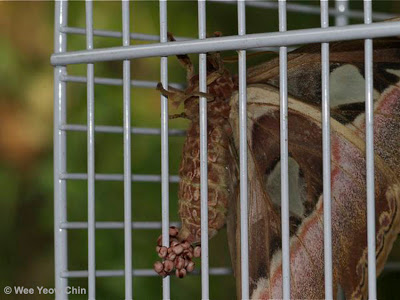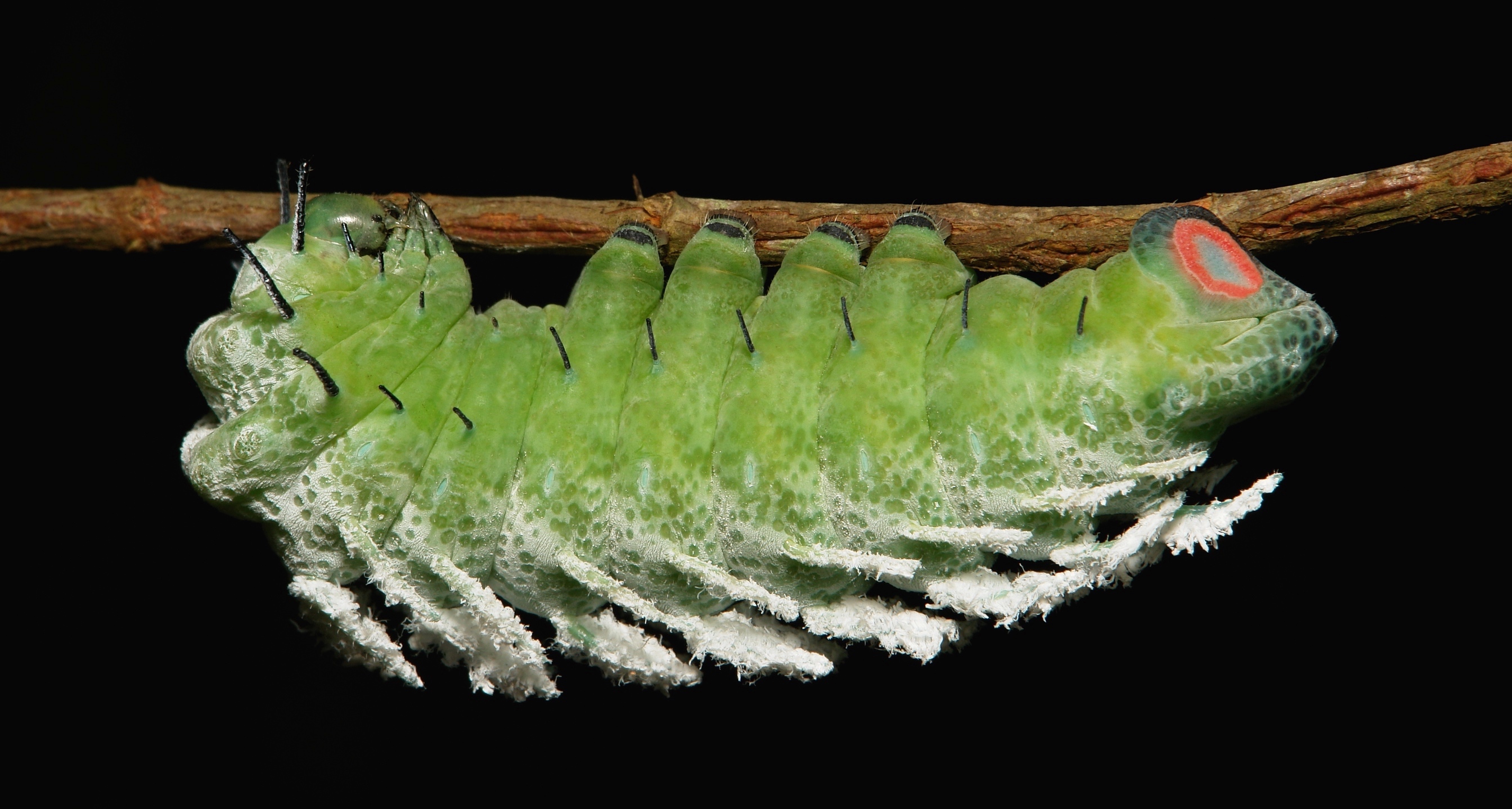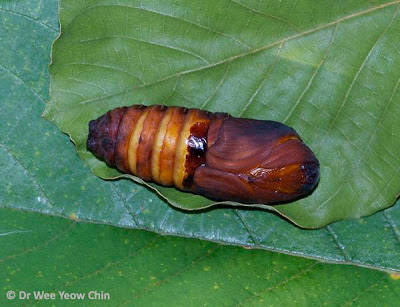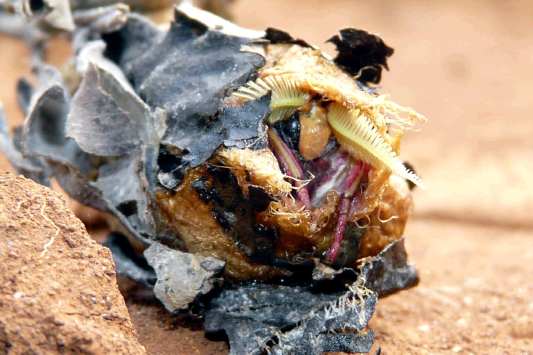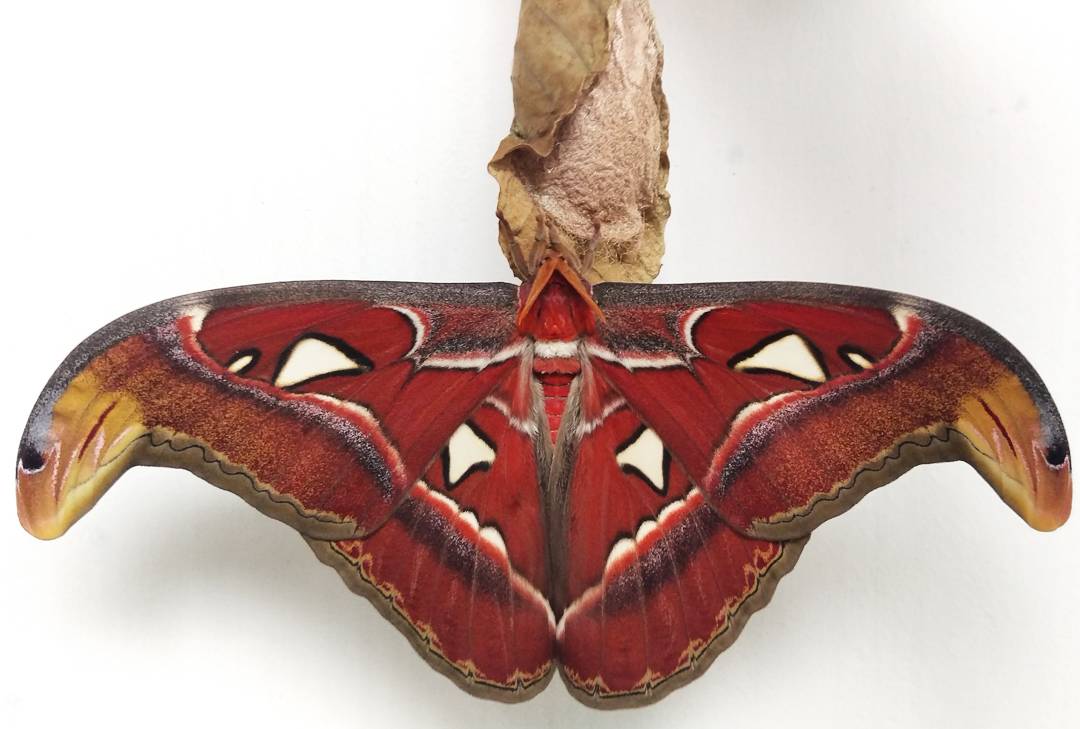 |
| Figure 1: Atlas Moth (Attacus atlas). Photo credit: Leon Krancher (Permission Obtained) |
[1.0] Overview
Table of Contents
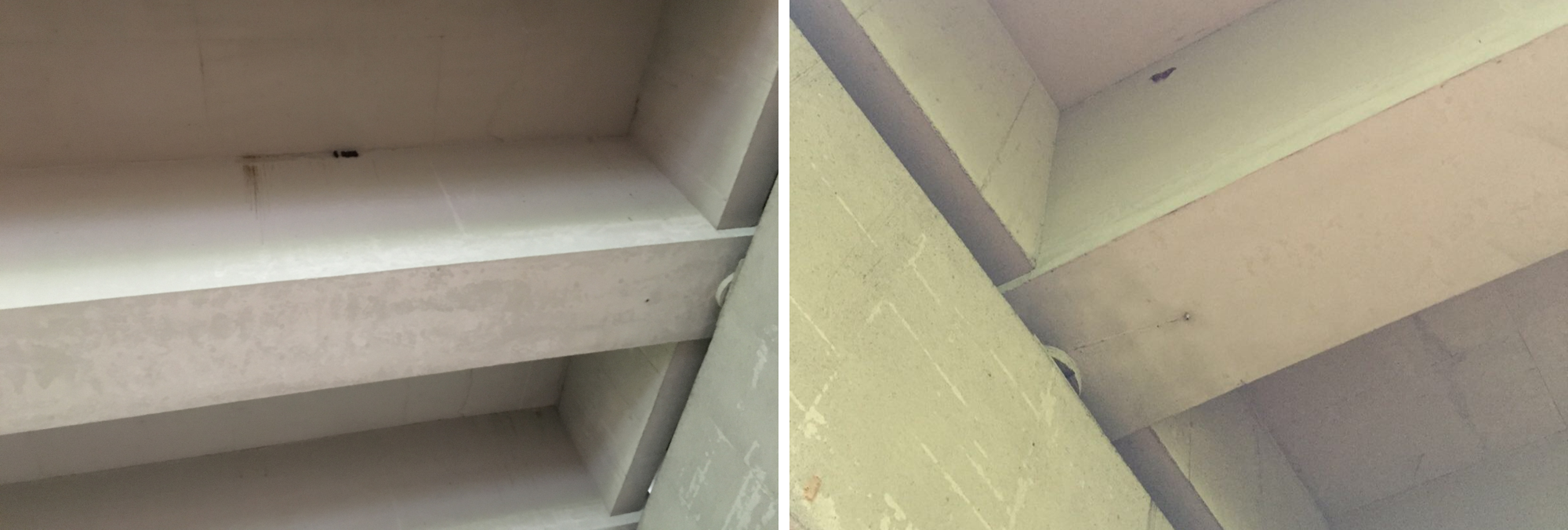 |
| Figure 2: Photo credits: Sebastian Ow (left); Angela Chan (right)(Permission granted) |
Lesser dog-faced fruit bats (left) and an Atlas moth (right) hanging out in the same area! Did you get them right?
You have just stumbled onto a moth that is as large as if not larger than some birds and bats! Not convinced? Take a closer look!
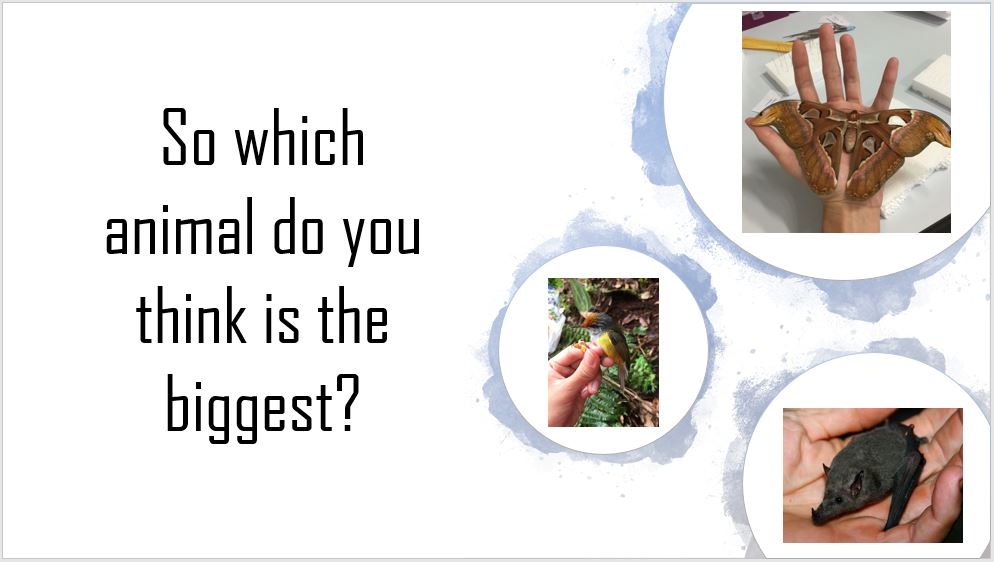 |
| Figure 3: Size comparison between a bird, a bat and the Atlas moth! Image adapted from various sources [1], [2], [3] |
More recently, the massive caterpillars of this moth inflicted terror and struck fear into the hearts of Yishun Town residents in April earlier this year, gobbling up the leaves of some of the trees there leaving behind several barren trees.
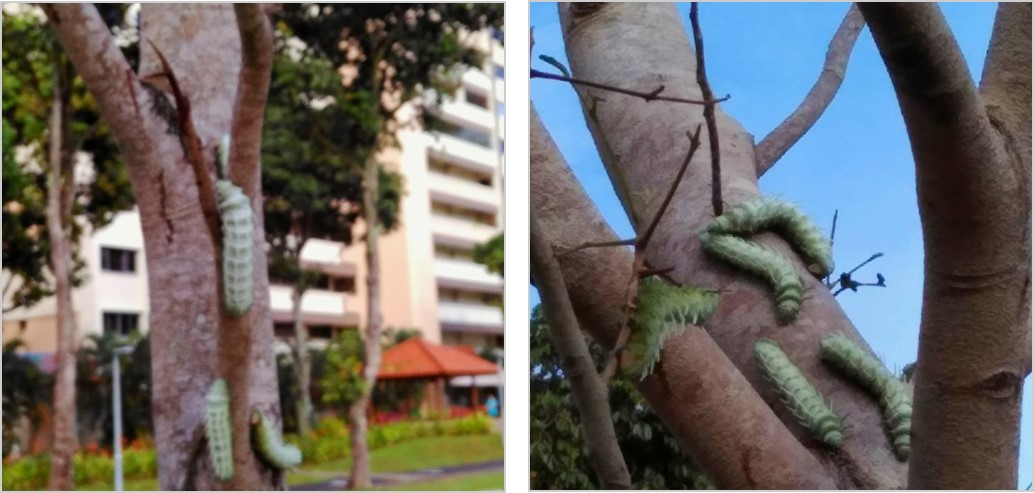 |
| Figure 4: The Invasion of Yishun? Photos credit: Christopher Yap (Permission obtained) |
It even joined the ranks of terrifying occurrences that had happened in Yishun estate such that it made it into a movie trailer (parody)! Check out the trailer below (1mins 22s) even though the caterpillar they featured is wrong......
Yishun terrors! Original video from YouTube by JUO Productions
Are you intrigued by this animal? Wait no longer and continue to read up more about this fascinating creature!Short for time? No worries and click here instead to simply read up the fun facts!
[2.0] Introduction
The Atlas Moth, Attacus atlas, belongs to the family Saturniidae, a family of huge and spectacular moths characterised by hair-like scales covering their body and lobed or sickle-shaped wings that are vibrantly coloured, in addition to having translucent eyespots or “windows” [1] . The Atlas Moth is the only species of saturniid moth present in Singapore [1]. It is often dubbed the largest moth in the world and is commonly found in Southeast Asia and other parts of Asia [1].
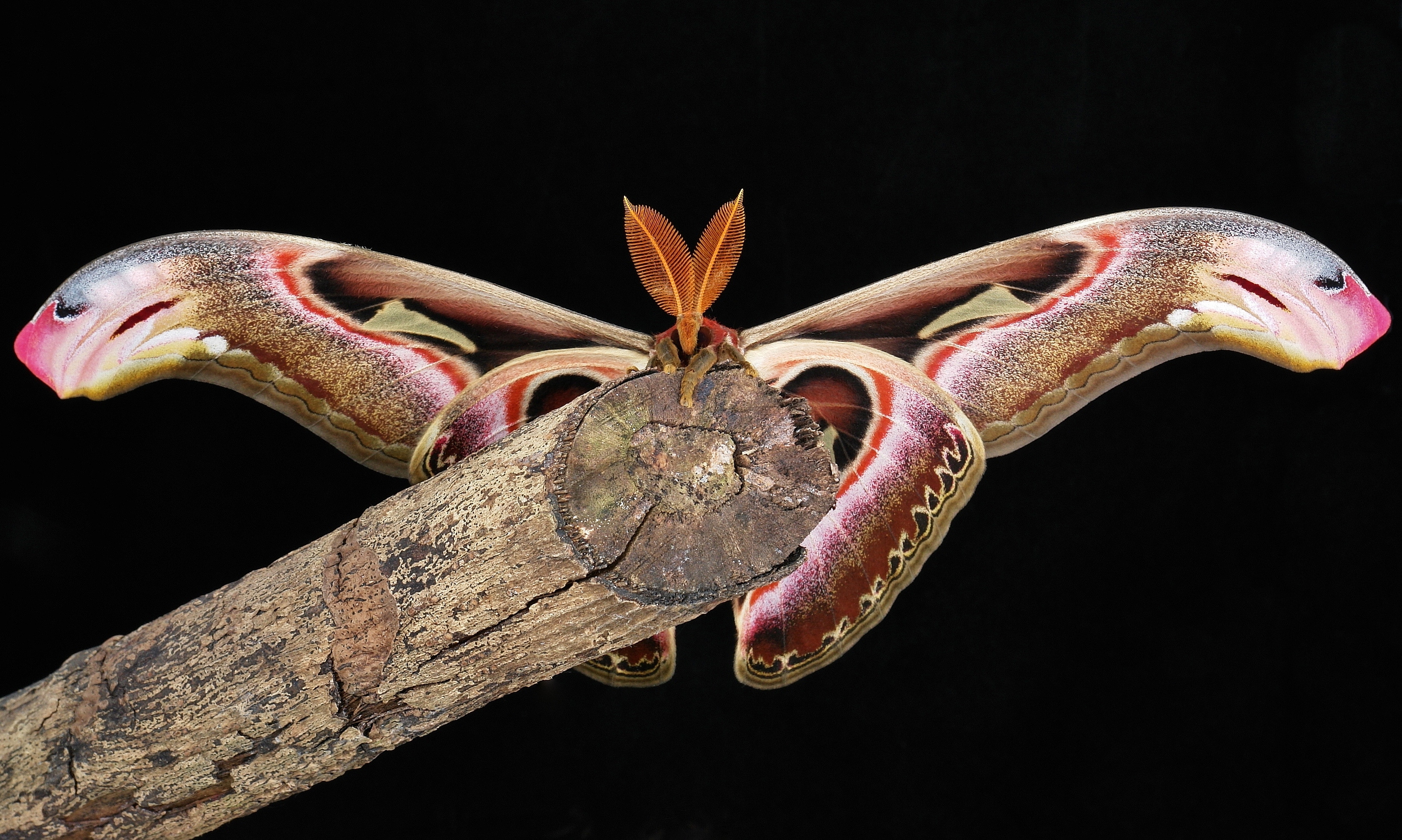 |
| Figure 5: Check out the magnificience of the Atlas moth! Photo credit: John Horstman (Permission pending) |
[3.0] Etymology
(Fun fact #1: What is behind the name Attacus atlas?)
Though the origin of the name of the Atlas moth is uncertain, it certainly holds many interesting meanings and interpretations. Firstly, the species name atlas is thought to be derived from Greek mythology, where Atlas, a colossal God who sided the Titans warred against the Olympian Gods and was punished and burdened with the task to hold the heavens on his shoulders forever [2]. The reference to the name here is simply the large size of the moth [2].
| Figure 6: The titan Atlas, bearing the weight of the heavens on his shoulders. Photo credit: GemaLe (Creative Commons) |
If you are a fan of Greek Mythology, be marvelled over by the mythological poetry weaved in the family of Saturniid moths. Famous examples of insects named after mythological figures include the Atlas Moth, Hercules Moth, Io Moth and Promethea Moth. Atlas and Prometheus were brothers who fought a war against Zeus [2]. Io was Zeus’ mortal lover but was turned into a cattle by Zeus to hide from his wife [2]. Io met Prometheus, who was chained to Mt. Caucasus by Zeus, when she was wandering in suffering [2]. Prometheus consoled her that she will be restored to human and will be the ancestresses of a glorious hero [2]. That turned out to be Hercules, one of the greatest hero of the mythological world, who eventually freed Prometheus [3]. Through the common names of the moths, Atlas, Hercules, Io and Prometheus have been reunited in the same family, Saturniidae.
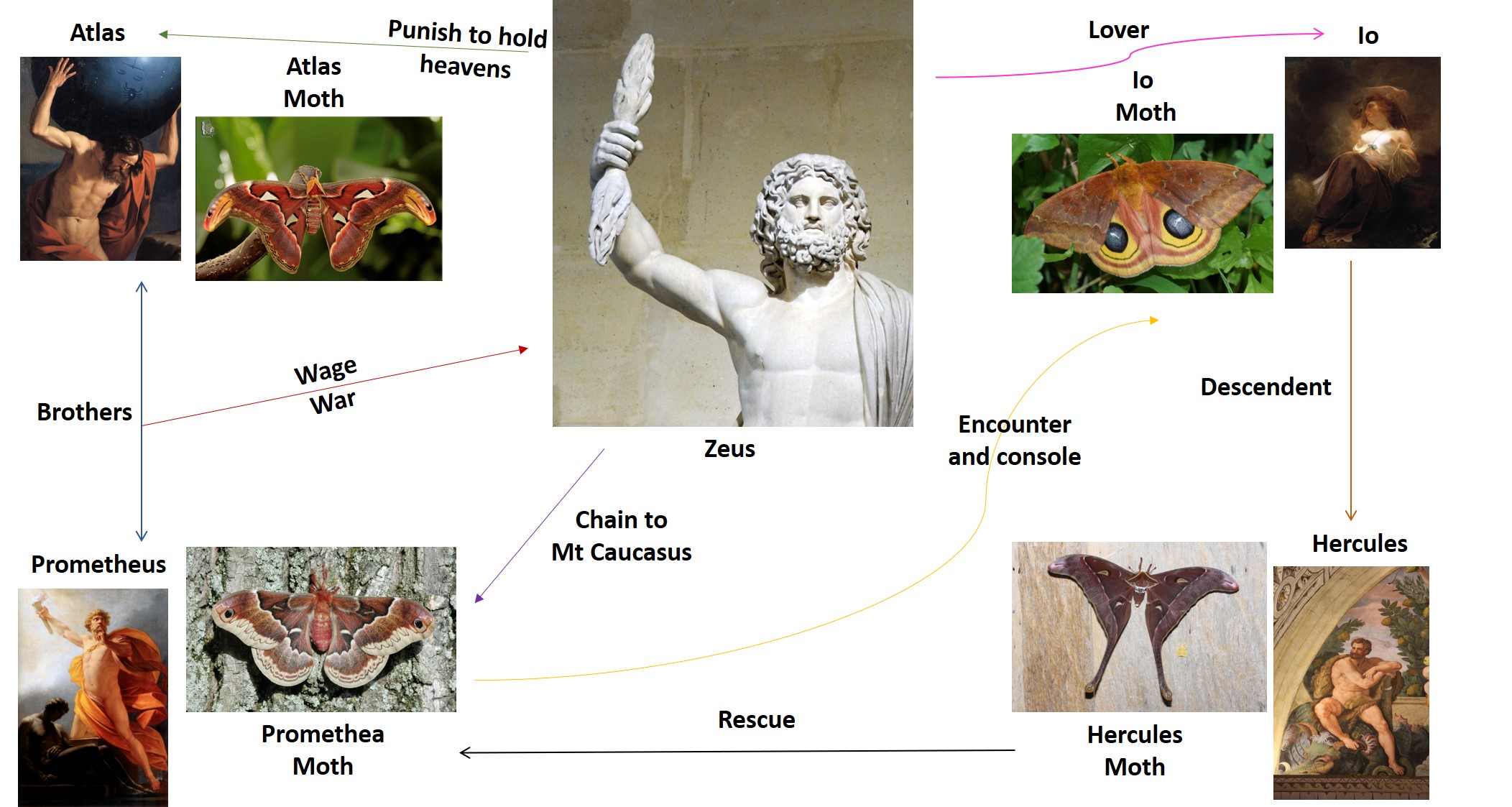 |
| Figure 7: Saturniid moths and their common names being involved in family squabbles in Greek Mythology! Image adapted from various sources [4], [5], [6], [7], [8], [9], [10], [11], [12] |
Another interesting perspective on the name “Atlas” seems to be due to the patterns on the wings of the Atlas Moth that resemble a paper map [4]. Interestingly, "Atlas" was only used to denote map collections ever since there was a publishing error by Rumold Mercator in 1595, which depicted Atlas the Titan as holding on to a globe rather than the celestial heavens on his shoulders [4]!
 |
| Figure 8: Atlas the Titan portrayed as holding on to a globe instead of the heavens. Photo credit: Biatch (from Wikimedia Commons) |
Lastly, in Hong Kong, the Cantonese name of the moth, 蛇头蛾, literally translates into “snake’s head moth” [5] , which can be observed in the wing tips of the moth resembling that of a deadly cobra.
 |
| Figure 9: Can you see the resemblance! Image adapted from Foo Maosheng (Permission granted) and Mpala Live! (Permission pending) |
Ready to move on to the next interesting fact? Let's go!!!
[4.0] Morphology
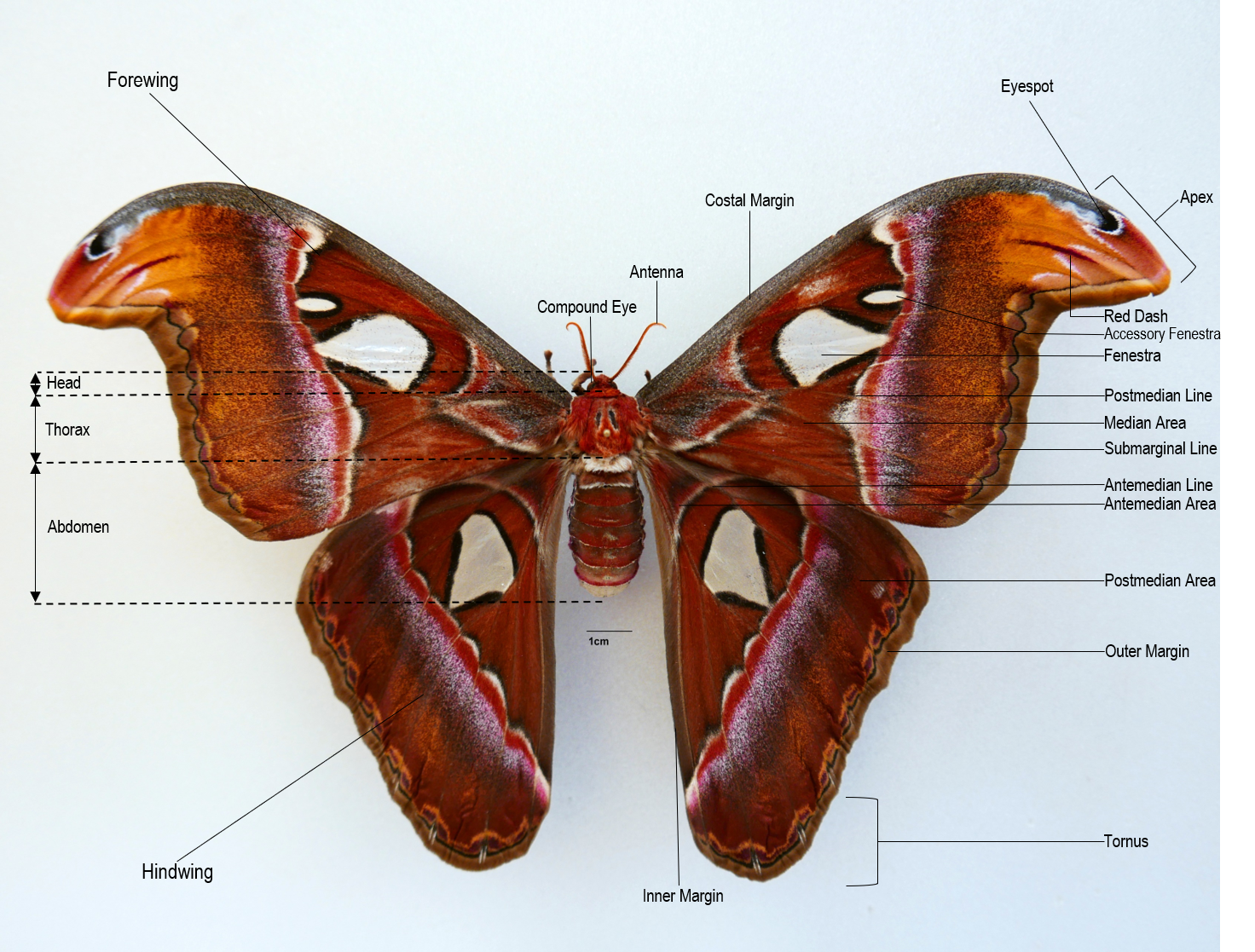 |
| Figure 10: Image adapted from Foo Maosheng (Permission obtained) |
Apart from being one of the world’s largest moth, Atlas Moths can be easily recognized by their heavily patterned wings in different reddish to brown shades. The wing tips of the forewings are hooked and translucent ‘window’ patches known as fenestrae are present in all four wings [6]. Basal area of the forewing has brown edges with red and pale black lines while the median area is typically red to brown. Apical wing tips are in shades of yellow to pink together with a large transparent hyaline eyespot with black edge [7]. A yellow to brown marginal band accompanied by a highly wavy black line is present in all four wings [7].
The orange brown antennae are bipectinate in both sexes while the legs are short, hairy and without spurs [8]. The head, thorax and abdomen are reddish brown with the basal segment and abdomen being paler with each segment marked with a pale fringe [8]. Females are typically larger than males as body length of a female can range from 39 mm to 40 mm while a male’s body length ranged from 30 mm to 36 mm [8] . Wingspan of the female ranged from 210 mm to 270 mm while a male’s wingspan ranged from 190 mm to 255 mm [7].
| Figure 11: Check out the ventral side of the Atlas moth! Photo credit: Foo Maosheng (Permission obtained) |
[4.1] Mouthparts
(Fun fact #2: Where is the mouth?)
Perhaps one of the most unusual morphology of the adult moth for both sexes is that they lack fully formed and functional mouthparts [9], which is essentially having no mouth! As such, the adults do not feed at all and spend their short 1 to 2 weeks of adult life relying entirely on the fat reserves that the larval stage has built up to survive [9]. (More of the feeding behaviour in later sections!)
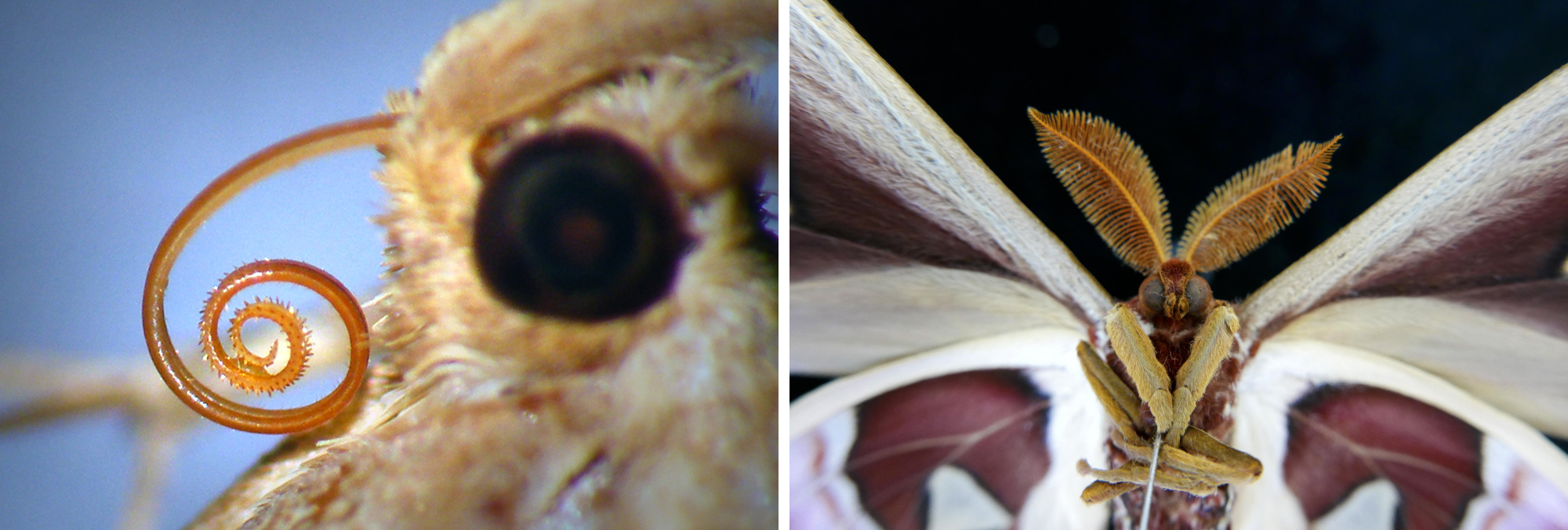 |
| Figure 12: Check out the proboscis of a typical moth (left) compared to the reduced mouthparts of the Atlas moth (right)! Photo credit: (left) Grover Schrayer (Permission pending) (right) Foo Maosheng (Permission obtained) |
Alright you're hooked, heading on to the next fun fact~
[4.2] Sexual Dimorphism
The Atlas Moth is sexually dimorphic [10]. Firstly, females are much larger than the males [11] . Secondly, the antennae differ between the two sexes [11]. The first difference is the antennae of the male is wider and longer than the female [11]. The second difference is the male’s antennae are much more feathery than the females [11] . The purpose of this is to enable males to track down the stationary females by her pheromones [10].
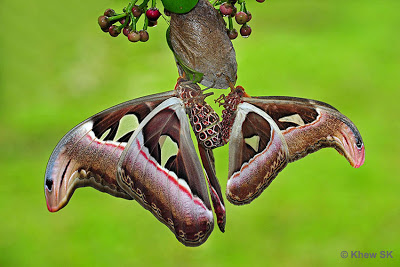 |
| Figure 13: A pair of Atlas Moth copulating. Notice how much larger the female (left) is as compared to the male(right)! Photo credit: Khew SK (Permission granted) |
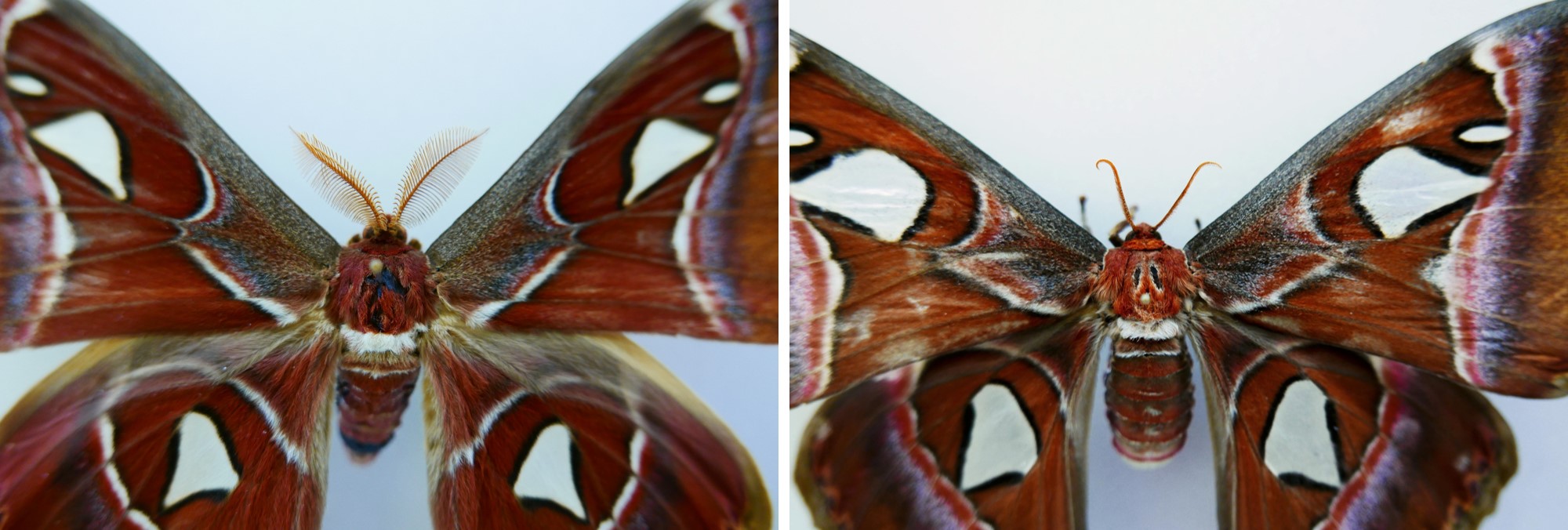 |
| Figure 14: Comparing the antennae of the male (left) and female (right) Atlas moths. Photos credit: Foo Maosheng (Permission obtained) |
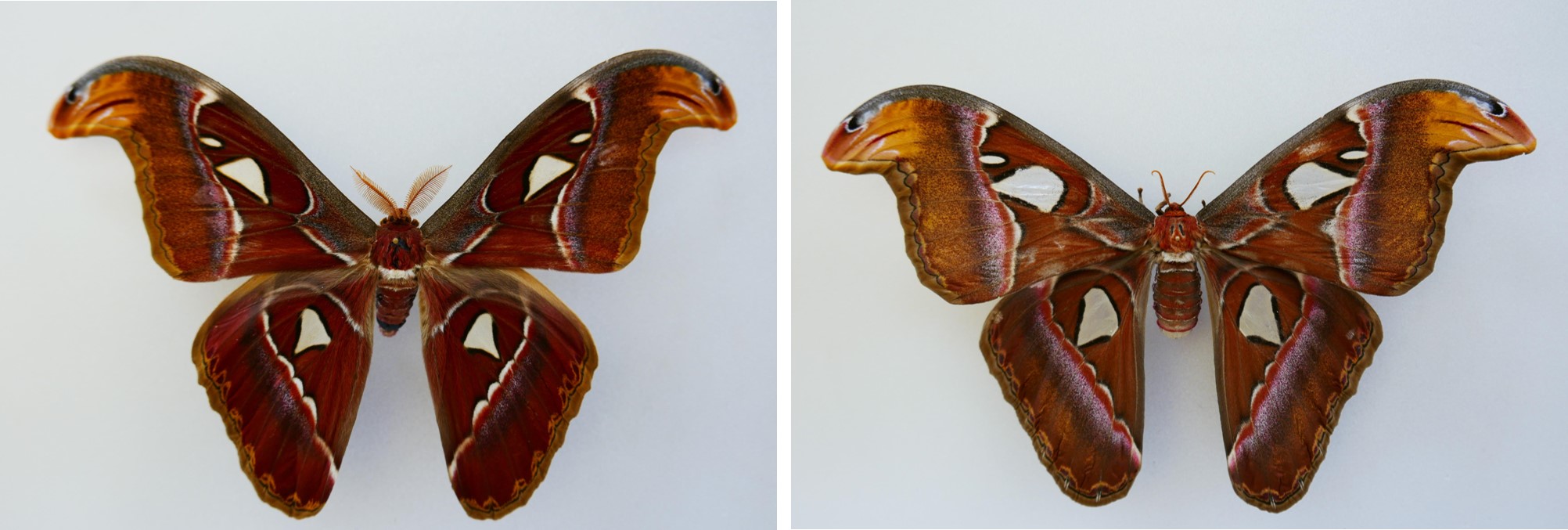 |
| Figure 15: Comparing the fenestrae of the male (left) and female (right) Atlas moths. Photo credits: Foo Maosheng (Permission obtained) |
Thirdly, it is possible that the ‘windows’ of the wings may differ for both genders. From the figure above, the ‘windows’ of the female seems to be wider, larger and rounder as compared to the more angular and triangular ‘windows’ of the males [10].
[4.3] Size
(Fun fact #3: Is the Atlas moth (Attacus atlas) the largest moth in the world?)
Despite the claim that the Atlas Moth is the largest moth in the world, we have to take a look at some of the other contenders. The White witch moth, which has claimed the title the largest moth in the world in terms of wingspan remains undisputed [12], and more recently, the Hercules Moth, which claims to be the largest moth in the world in terms of wing area stands in the way of the current title holder, the Atlas Moth.
Let us look at some of our contenders!
Presenting to you the titan from the Neotropics [12], the White witch moth (Thysania Agrippina)!
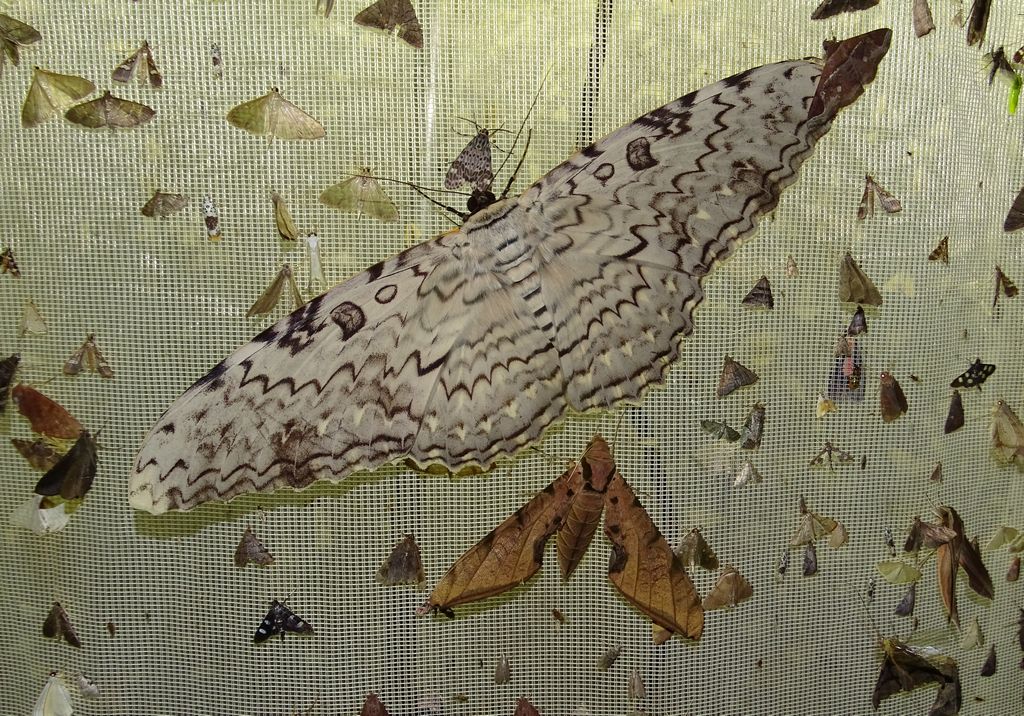 |
| Figure 16: The White witch moth (Thysania Agrippina). Photo credit: Chris Engelhardt (Permission pending) |
Next up, is the champion who is endemic to the Australia and Papua New Guinea [13], the Hercules moth (Coscinocera hercules)
Let the showdown begin!!!
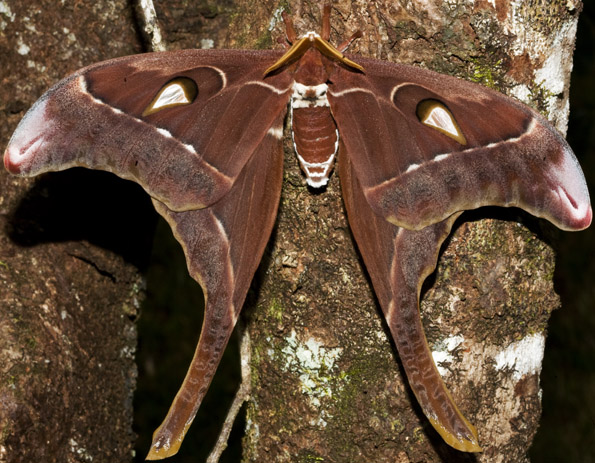 |
| Figure 17: The Hercules Moth (Coscinocera hercules). Photo credit: Jennifer Marohasy (Permission pending) |
In terms of wingspan, the largest White Witch moth recorded thus far measures up to 30.8cm, followed by Hercules Moth with a wingspan up to 28 cm and finally the Atlas Moth which measures up to 25 cm [13]. Therefore, the champion for the largest moth wingspan is undisputedly the White Witch moth!
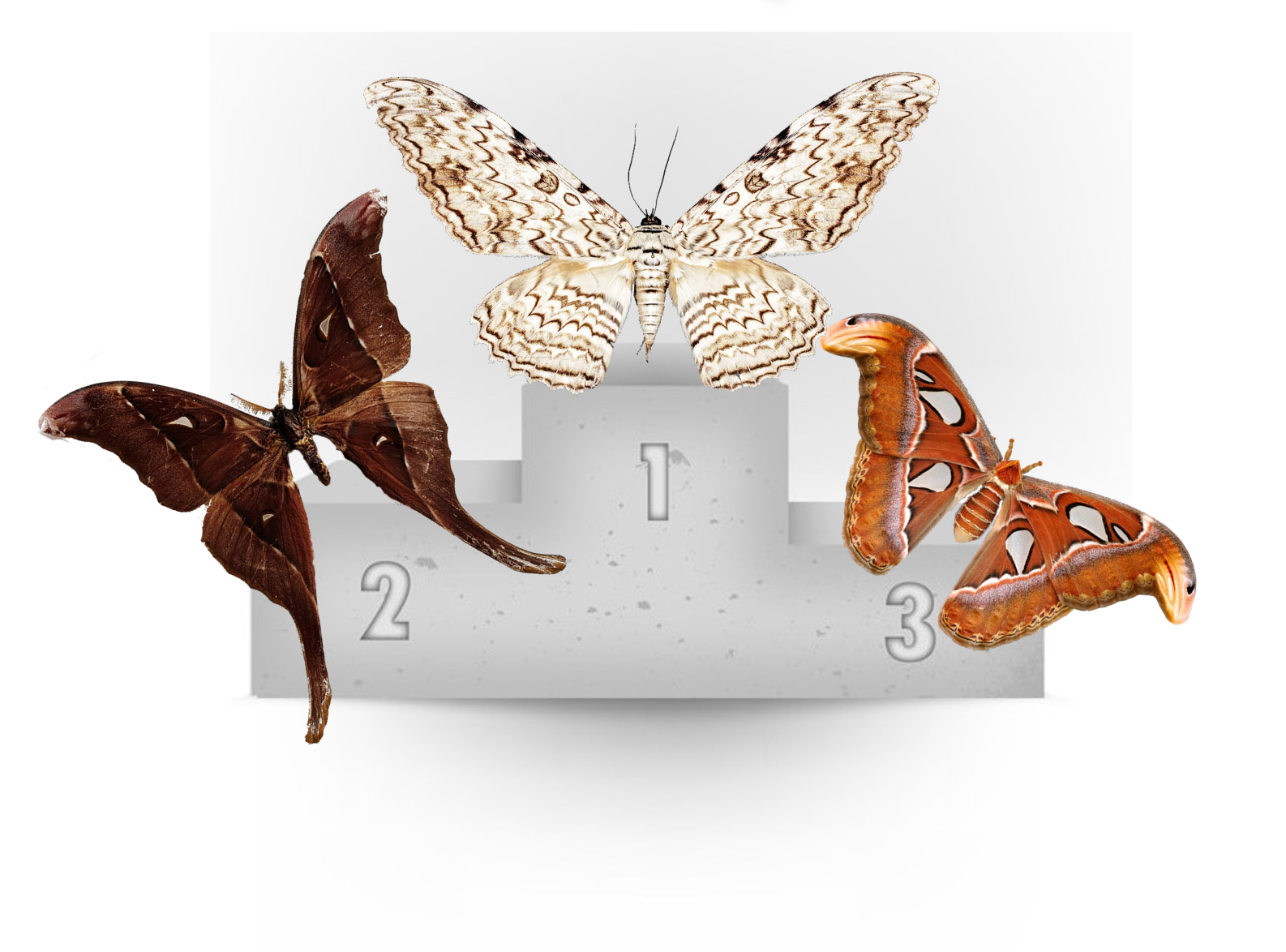 |
| Figure 18: Congrats to the White witch moth for being the largest moth in the world in terms of wingspan! Image adapted from various sources [13], [14], [15] |
In terms of wing area, the White Witch Moth does not match up to the other two contenders [12]. It has been documented that the Hercules Moth’s record for its wing area is at 300 cm2 [14] while the largest documented Atlas Moth has a wing area of 400 cm2 [15]! As such, currently, the largest moth in the world in terms of wing area is the Atlas Moth (until more updated literature suggest otherwise).
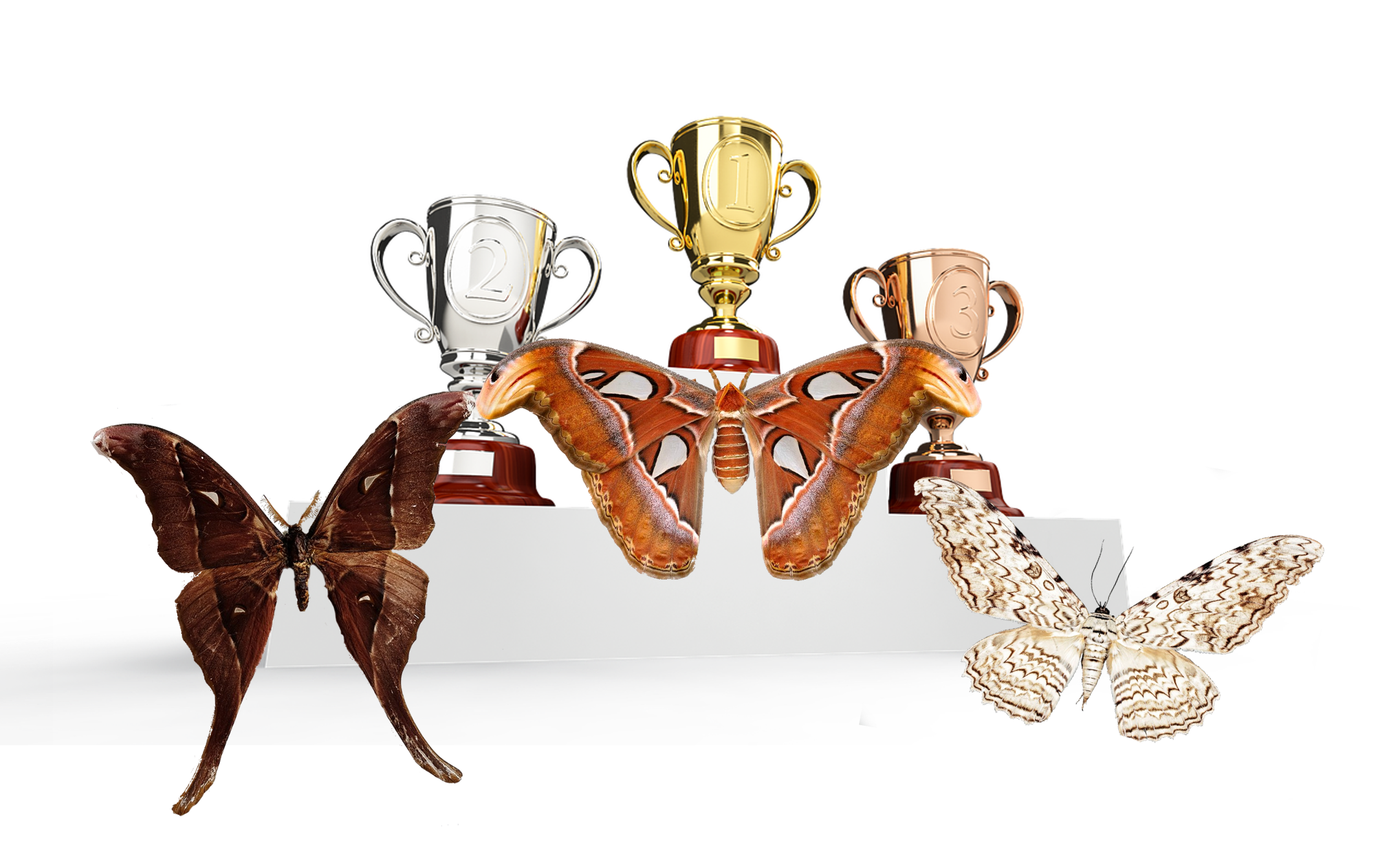 |
| Figure 19: A close call, but the Atlas moth managed to clinch first for the largest moth in terms of wing area! Image adapted from various sources [13], [14], [15] |
2 more fun facts to go, what are you waiting for!
[5.0] Biology
[5.1] Life History
The table below shows the holometabolous life history of the Atlas moth [7].
| Developmental Stage |
Description of Developmental Stage |
||||
|---|---|---|---|---|---|
|
Oviposition Ovipositing of eggs by a female Atlas Moth in captivity. |
||||
|
Eggs Oval, slightly dorsoventrally flattened, colour ranges from dull white to pinkish grey with a brownish strip and polygonal punctuations. Embryonic period lasts 10-11 days |
||||
|
1st Instar Smooth and black head with pinkish grey body with brownish strips. Black irregular markings on the inter-segmental region. 1st instar larvae ate up the egg shell. The first instar larval duration is 4-5 days. |
||||
|
2nd Instar Body is dull white with black irregular markings. Deep orange elongated markings appear on anterior and posterior lateral region of the body. Duration of this stage is 8-10 days |
||||
|
3rd Instar The body is icy white to greenish. Instar duration is 13-14 days. |
||||
|
4th Instar The larva is greenish and the whole body is covered with lime like powder. This instar lasts for 10-11 days. . |
||||
|
5th Instar Greenish, the dorsal tubercles are whitish while the lateral tubercles are blue with black tips. This instar lasts for 12-13 days. |
||||
|
6th Instar The larva is same as the fifth instar larva. The difference is observed in terms of size, weight and larval duration only in the sixth instar. This instar last for 14-15 days |
||||
|
Pupa Reddish brown Male pupal diapause (21-25 days) Female pupal diapause (23-27 days) |
||||
|
Cocoon Slight brown to greyish Male (5 – 6 days) Female (8 – 10 days) |
||||
|
Eclosion Eclosion takes place after 4 weeks and the emerging moth often remained clinging to the cocoon until their wings finish expanding and drying [9].Check out a video of an eclosing Atlas moth! Original video from YouTube by Dr Wee Yeow Chin |
Check out the complete development of an Atlas moth through the all of its lifecycles! Look at how it grows in size compared to the size marker!!!
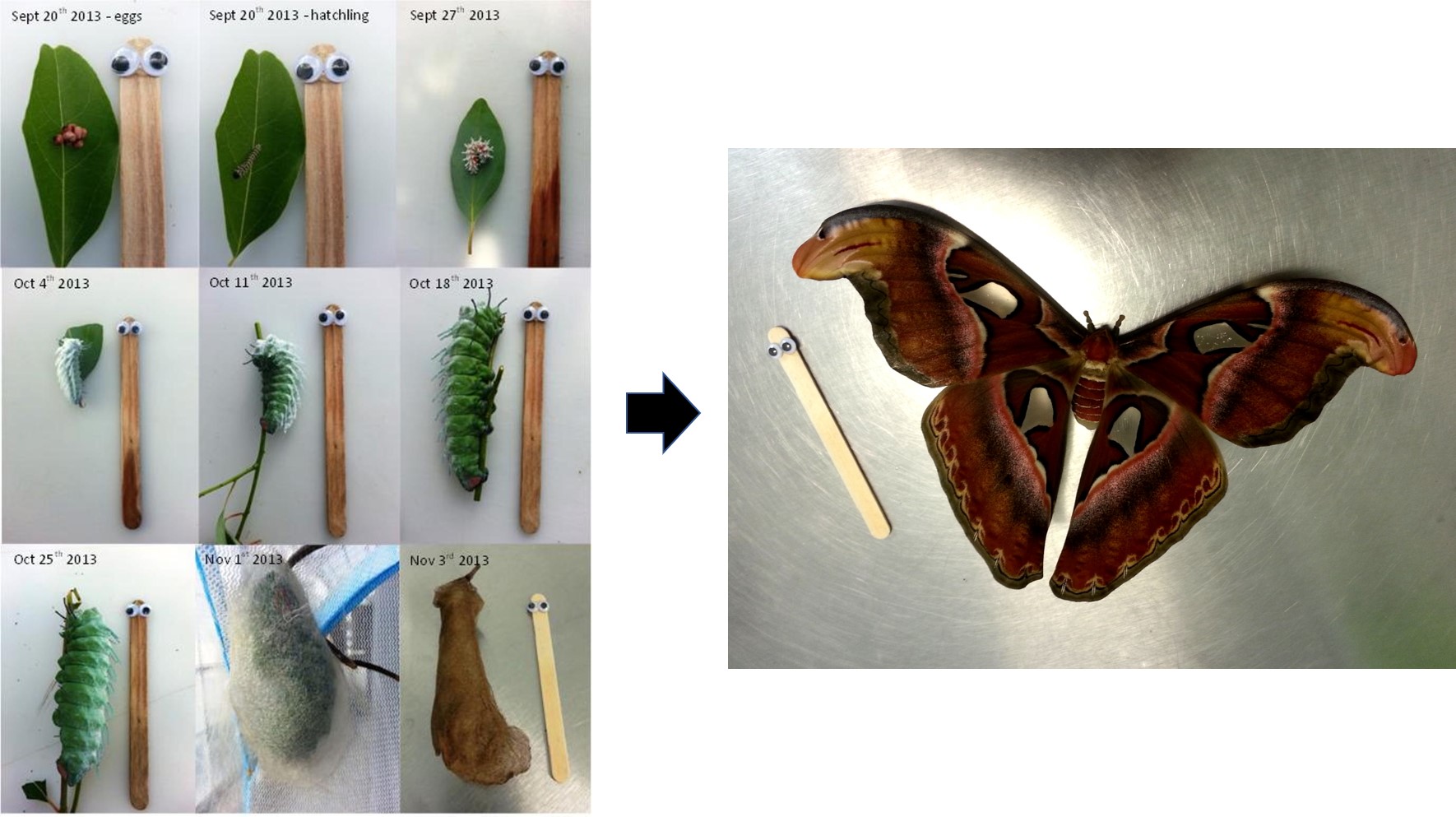 |
| Figure 32: Photos credit: Celeste Castro (Permission obtained) |
[5.2] Behaviour
[5.2.1] Mating Behaviour
Female Atlas Moths are sexually passive, emitting powerful pheromones that can attract potential male suitors from several kilometres downwind. Despite their massive wings, Atlas Moths are unsteady fliers and thus the female often stays close to its cocoon after eclosion while seeking an optimal perch where her pheromones will be best delivered [16]. On the other hand, male Atlas Moths are able to detect the pheromones via the chemoreceptors located in their large feathery antennae and home in onto the female [10].
Successful meetup of a pair of Atlas Moths will remain together and mate for up to more than 24 hours. Subsequently, they detach from each other and the female will fly off to lay her eggs on the leaves of a suitable host plant [17]. Atlas moths adults are semelparous, meaning that their lives are characterised by death after their first reproduction event. As such, the fecundity of the female Atlas Moth is high as she can lay about 300 – 400 eggs in that one reproduction event [28].
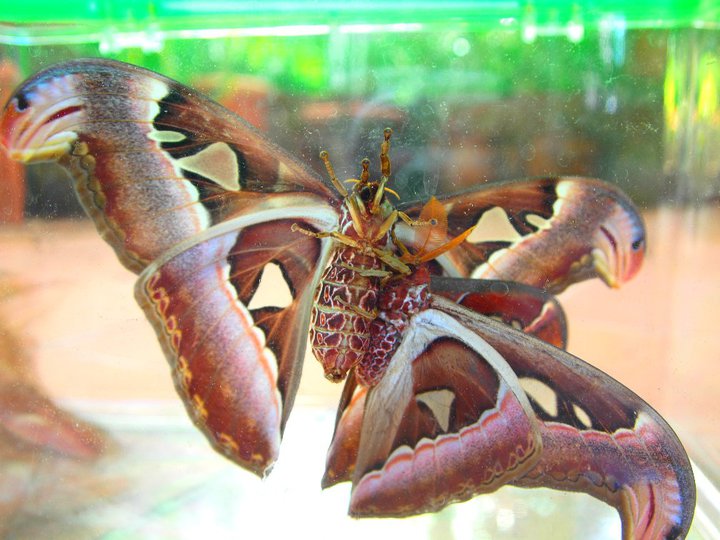 |
| Figure 33: A copulating pair of Atlas moths! Photo credit: Sean Yap (Permission obtained) |
[5.2.2] Feeding Behaviour
The polyphagous larvae of the Atlas Moth feed on a variety of different host plants, whereby records have shown that there are at least 90 genera of plants in 48 families that they feed on [6]. The table below shows only a small fraction of the host plants found locally in Singapore. Typically, the larvae feed only on the mature leaves of host plants and ignore the other parts (developing leaves, flowers, fruits and woody stems). They will devour the leaves of the entire plant before moving on to nearby plants to continue feeding. Evidence of their carnage includes large frass pellets that are found on the ground beside host plants where the feeding has occurred. Given their polyphagous nature, they will most likely complete their development on their host plants [18].
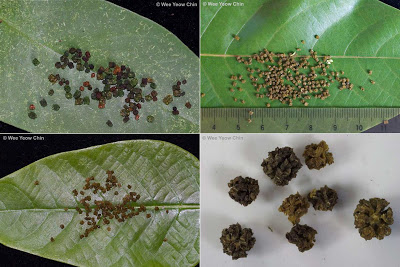 |
| Figure 34: Photo credit: Dr Wee Yeow Chin (Permission obtained) |
In contrary, despite its immense size, the adults do not feed at all as neither sex possess fully functional mouthparts. As such, for their 1 to 2 weeks of adult life, they rely entirely on the fat reserves that the larval stage has built up to survive [9].
[5.2.2.1] Host Plants
Table of some host plants found in Singapore: (Check out more information on the host plants with the hyperlinks provided)
| Scientific Name |
Common Name |
Status |
Photos |
||
|---|---|---|---|---|---|
| Melastoma malabathricum |
Sendudok, Singapore Rhododendron |
Native |
|
||
| Nephelium lappaceum |
Rambutan |
Native |
|
||
| Averrhoa carambola |
Star Fruit |
Exotic |
|
||
| Mangifera indica |
Mango |
Exotic |
|
[5.2.2.2] Pest & Management
Due to their voracious appetite, Atlas Moth caterpillars can result in significant defoliation of a plant or small tree [18]. Though it is not labelled as a major pest, in some localities and during certain seasons, it may be elevated to pest status. Records have shown that it is a pest of tea and quinine in Java and a major pest of cinnamon in parts of Malaysia [19].
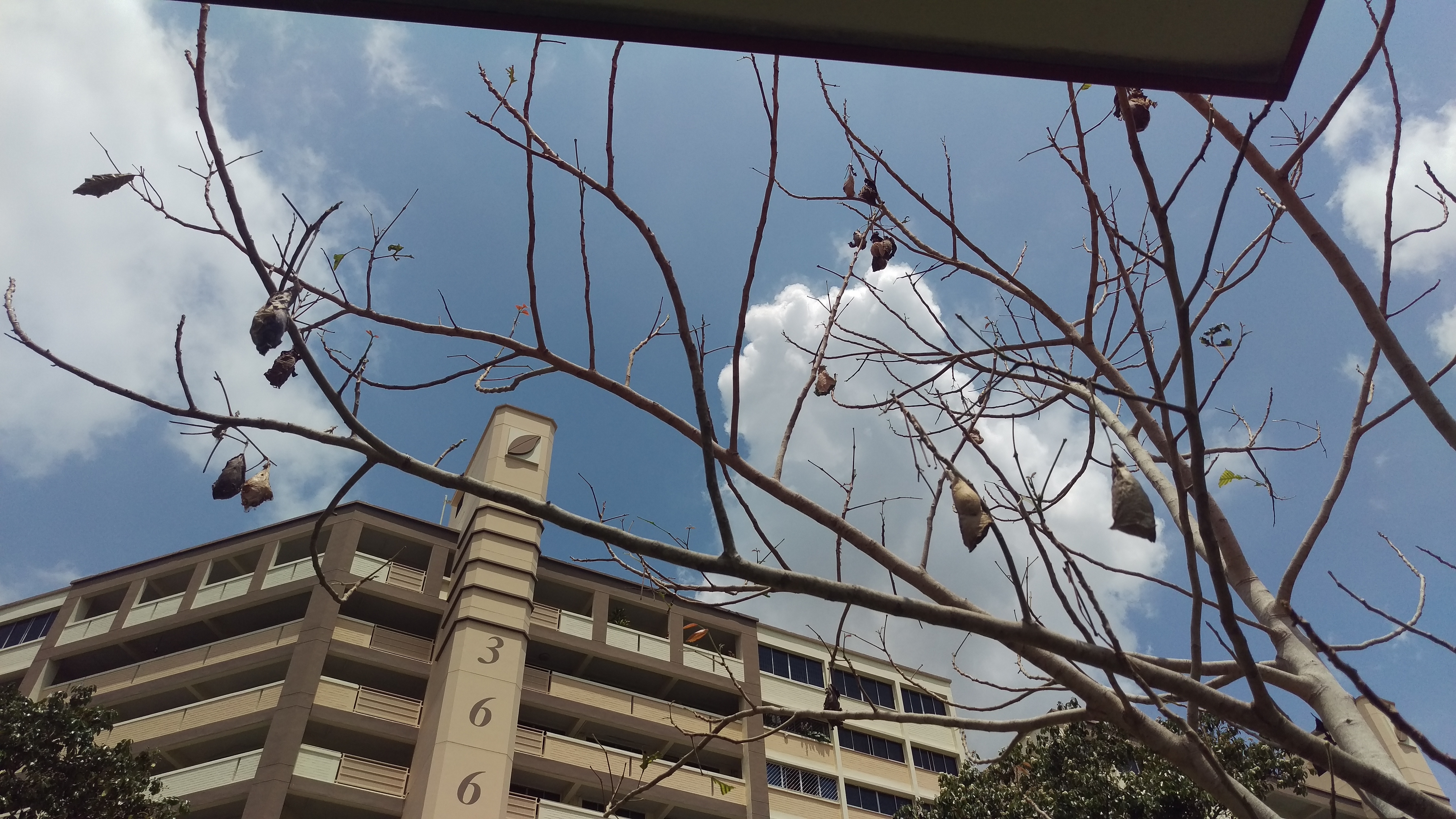 |
| Figure 39: Look at the state of devastation of the tree! Photo credit: Foo Maosheng (Permission granted) |
Pest management controls involve removing the cocoons of Atlas Moths by hand as often females oviposit on the same trees where they have matured and developed as larvae. Larvae can be removed by hand too due to their large sizes. Unfortunately, when these larvae and cocoons are found, most of the damage has already been dealt! Not surprisingly, the aftermath of their carnage is the main key to their detection. Chemical insecticides will also be effective against the larvae, but polyphagous insects tend to be able to better detoxify such chemicals. However, perhaps the most innovative solution is to encourage locals to ‘harvest’ the cocoons diligently for sericulture which not only brings them fewer pest problems but also a potential for economic gains [18].
[5.3] Defence Adaptation
(Fun fact #4: How does it survive when it’s so big?)
[5.3.1] Imaginal gigantism
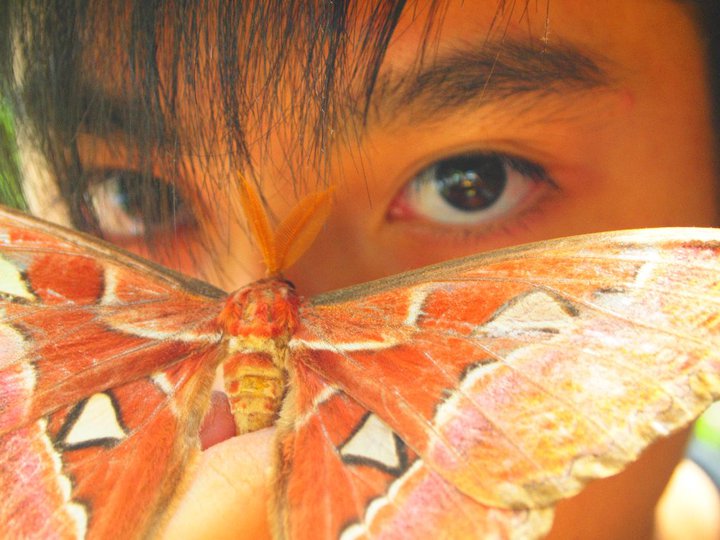 |
| Figure 40: The massive size of the Atlas moth is actually a defence strategy! Photo credit: Sean Yap (Permission obtained) |
[5.3.2] Crypsis
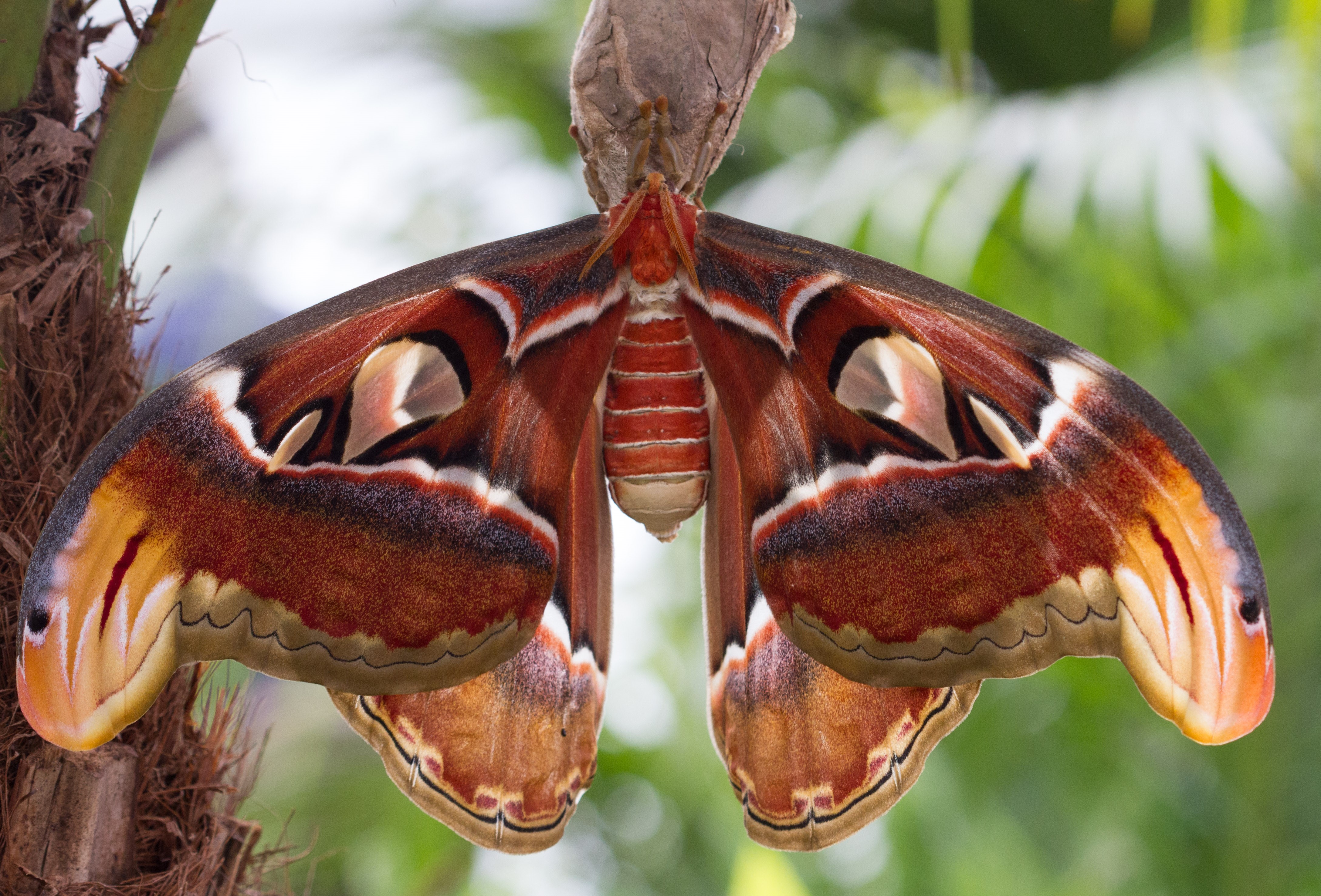 |
| Figure 41: You can see how light penetrates through the ‘windows’ of the Atlas moth here! Photo credit: Godless Graham (Permission pending) |
The contrasting earthly colours of the Atlas Moth gives it the benefit of crypsis. Its diurnal resting position is often hanging by its legs on a branch with all four wings positioned in a plane or at an obtuse angle, with its forewings folded down partially to cover part of the hindwings. The forewings can be folded down far enough such that the fenestrae (‘windows’) of the forewing and hindwing become superimposed, thereby allowing light to penetrate, disrupting the image of the moth and further enhancing the cryptic patterns among the vegetation, giving it the perfect camouflage [6]!
[5.3.3] Defensive Behaviour of Adults
The tips of the Atlas Moth forewings resemble the head of the snake (remember its Cantonese name, 蛇头蛾, which literally translates into “snake’s head moth”), which may facilitate its defensive behaviour [6]. It is believed that when disturbed or threatened, the moth will drop to the ground and flap its wings, thereby giving its potential predator an illusion of a snake movement and hence able to deter the predator.
Check out the wing flapping! Original video from YouTube by Richard's Inverts
[5.3.4] Defensive Behaviour of Larvae
| Figure 42: Sketch of an Atlas moth caterpillar showing the secretion-spraying scoli by Deml & Dettner. (1994). Obtained and accredited under fair use |
The Atlas moth larvae are able to produce defensive secretions as part of their defence mechanism. These secretions are produced from a series of integumental outgrowths called scoli, on the thoracic and last abdominal segments indicated as black spots and marked by arrows in the figure above. The Atlas Moth caterpillar typically discharges their secretions either as a droplet or sprayed to relatively great distances when disturbed. The droplet secretion contains metabolite substances that function as feeding deterrents against certain species of ants, which are known to be the main arthropod predators of caterpillars. It is also capable of defending itself from vertebrate predators such as birds by spraying an irritant secretion into the eyes of birds from a distance of 20-50cm away [20].
Another defensive secretion the Atlas Moth larvae can produce is a white wax layer covering the surface of its body. When disturbed, the movement of the larvae with its white waxy surface may disorientate predators and parasitoids. Furthermore, the unstable surface of the larval body coupled with flakes of the wax coat may physically inhibit oviposition and prevent the easy adhesion of parasitoid eggs to the dorsal surface of the larvae, especially for tachinid and hymenopterous parasitoids [6].
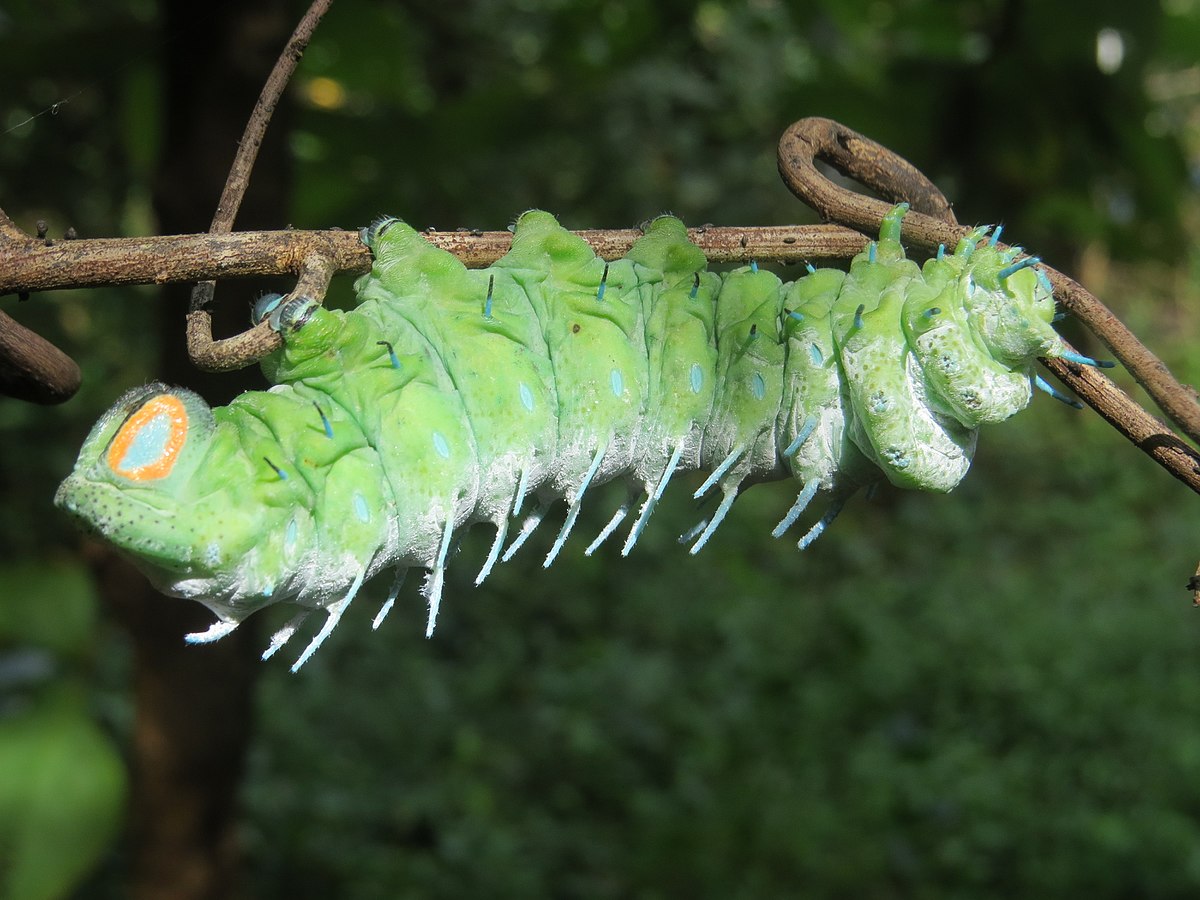 |
| Figure 43: Check out the white waxy covering on the dorsal surface of the larva! Photo credit: Vinayaraj (licensed under the Creative Commons Attribution-Share Alike 4.0 International license) |
5.3.5] Cocoon design
The hanging cocoons of the Atlas Moth are carefully concealed among the foliage of their largely evergreen hosts. The cocoons are connected to their host plants via a strong peduncle which prevents them from falling to the ground where they would be vulnerable to non-arboreal predators such as rodents. This method of cocoon placement also impedes birds’ predatory attacks as the swinging motion of the hanging cocoon will make it difficult for the beak to penetrate the cocoon. In addition, the cocoon is cleverly designed such that it includes an anterior exit valve that prevents entry from any predators or parasitoids outside [6].
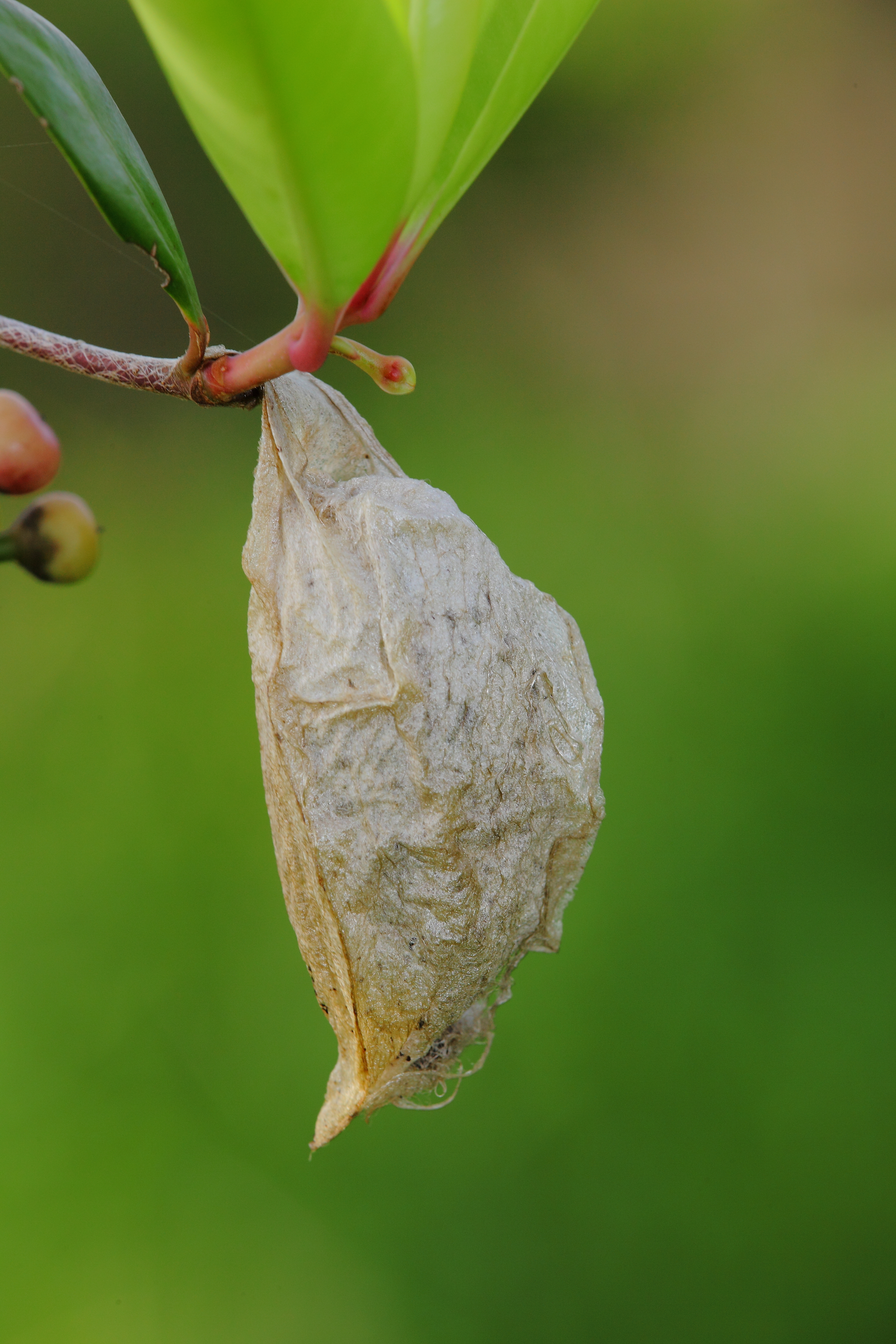 |
| Figure 44: Photo credit: I_Love_Butt2010 (Permission pending) |
Finally, onwards to the last fun fact :)
[5.4] Parasitism
Tachinidae (Diptera)
It has been recorded that tachinid flies do attack the Atlas Moth and parasitize the larvae. The maggots of the flies complete its initial development before leaving the host cocoons through the preformed exit and burrow into the ground to pupate [6]. An example of a tachinid fly known to parasitize Atlas moth is Exorista sp., as shown below.
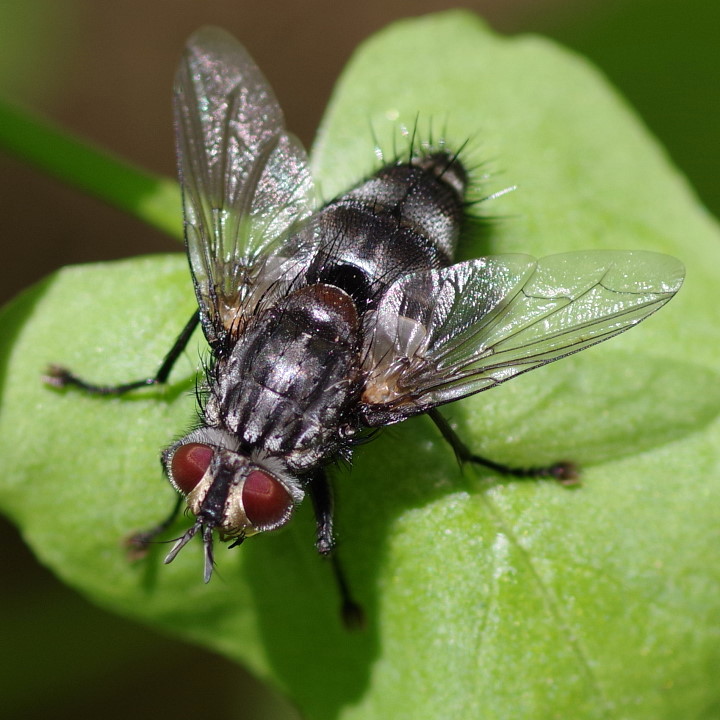 |
| Figure 45: Photo credit: The Diptera Site (licensed under a Creative Commons Attribution CC BY Licence) |
Species of chalcidoid wasps have been recorded parasitizing the eggs of the Atlas Moths, whereby upon hatching, larvae of Atlas Moths and adults of these wasps emerged from the same brood of eggs [6]. An example is Anastatus sp. that is shown below, parasitizing eggs of another insect.
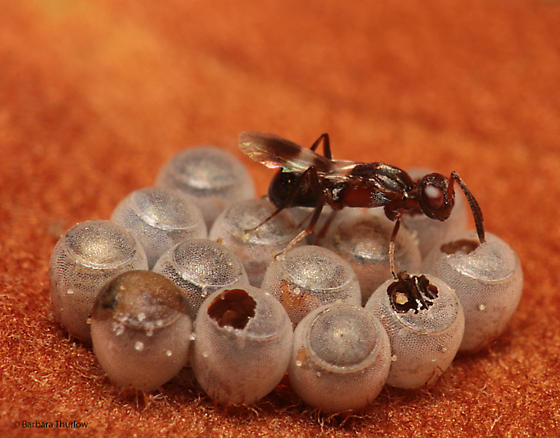 |
| Figure 46: Photo credit: Barbara Thurlow (Permission obtained and accreditated under copyright) |
The genus Apanteles of the braconid wasps is large and widespread and often the parasitoids of lepidopteran larvae, including Atlas Moth. The larvae of the Apanteles sp. spends most of its life inside its host and only observed to leave the host when preparing to undergo pupation [6]. This can be seen as tiny white cocoons adhering to the host larvae as shown below.
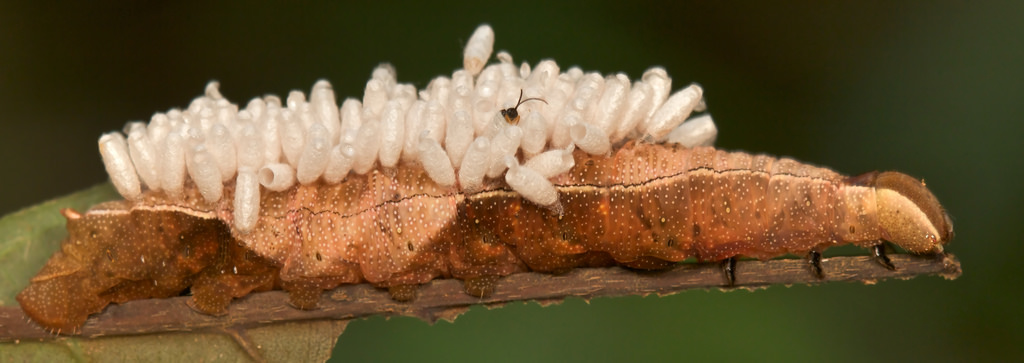 |
| Figure 47: Photo credit: Paul (Permission pending) |
Ichneumonid wasps, such as from the genus Enicospilus and Xanthopimpla are found to parasitize Atlas Moths. The wasps oviposit in host larvae (one parasite per host) but do not mature and pupate until the hosts’ larvae prepare their own cocoons. The result is the emergence of an adult wasp from the cocoon of the Atlas Moth [6]. An example of a Xanthopimpla sp. is shown below.
| Figure 48: Photo credit: © natureloveyou.sg (Permission obtained and accreditated under copyright) |
[6.0] Distribution
Atlas Moths are commonly found in Southeast Asia [9]. They have a broad distribution extending from the Oriental tropics to Borneo and Indonesia extending as far east as New Guinea [6].
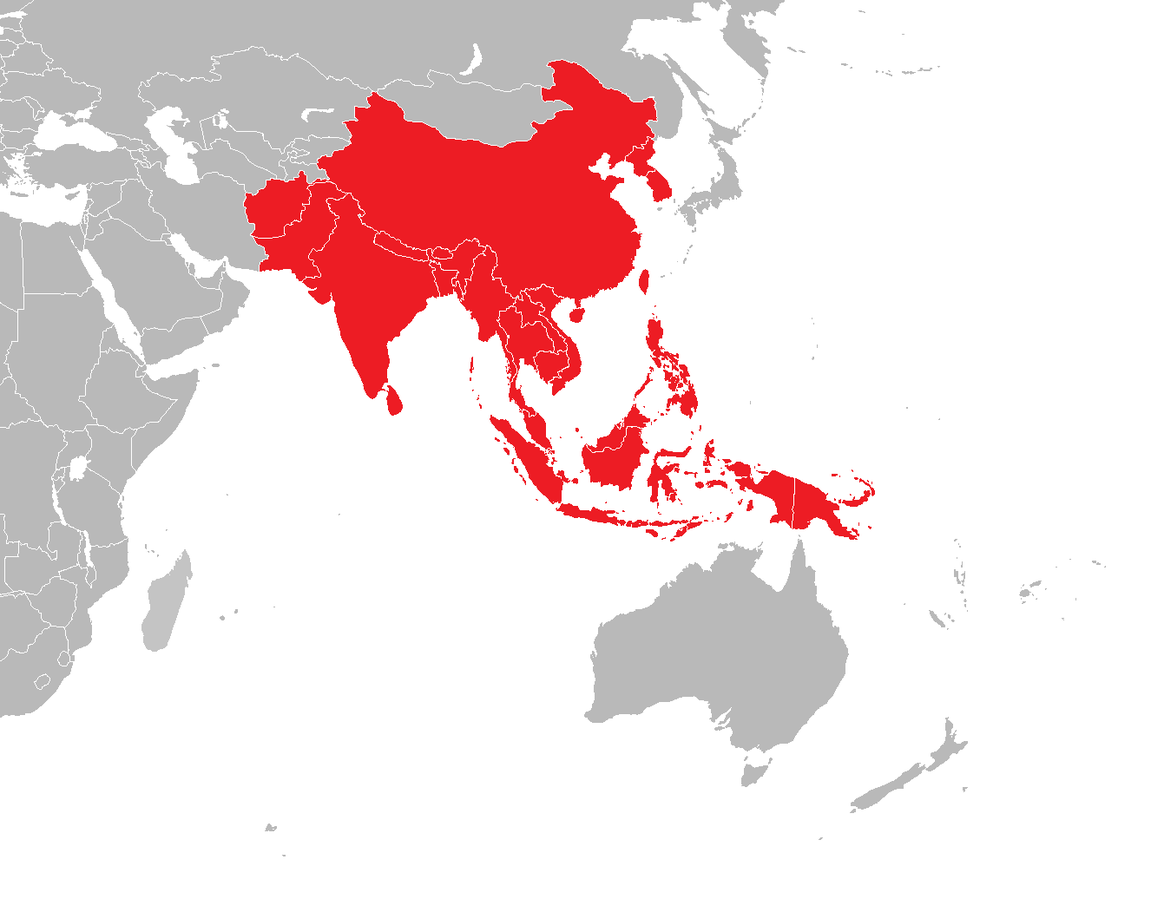 |
| Figure 49: Global distribution of the Atlas moth (Attacus atlas). Photo credit: Wikimedia Commons |
Figure 50: Map of local distribution of Attacus atlas. Created by Sebastian Ow
Atlas Moths are common in Singapore, especially in the period of November-January, although they can be found throughout the year [9].
[7.0] Human Associations
[7.1] As a popular icon?
Following the familiar Godzilla franchise created by Toho, it was suggested that Godzilla’s arch-nemesis, Mothra, was inspired by giant moth species such as the famed Atlas Moth. Mothra’s depiction on film showcased the various stages of the lepidopteran life cycle which starts off as a gigantic egg which hatches into a massive brown silkworm resembling caterpillar before pupating into a silken cocoon. This was then followed by eclosion of the adult Mothra, whose brightly coloured wings reflect some similarity to that of the Atlas Moth. Mothra has been one of Toho’s most popular creation, especially among female fans [21]. Check out how might Mothra fares against the gargantuan Godzilla below!
Godzilla vs Mothra! Original video from YouTube by Sascha Kucklick
[7.2] As Pets & Collection
Due to its magnificence and breeding ease, Atlas Moths are popular as pets for entomologists or people involved in breeding hobbies [27]. Interested pet collectors often purchase eggs from lepidopteran breeders for as much as $35 for 30 eggs! It is also seemingly very easy to hand pair Atlas Moths. Check out a tutorial of hand-pairing below!
Hand-pairing tutorial by a moth breeder! Original video from YouTube by Bart Coppens
In addition, they are prized collections even when they are dead. Framed, mounted and carefully preserved, the specimens of Atlas Moths prove to be a highly aesthetic wall decoration at home.
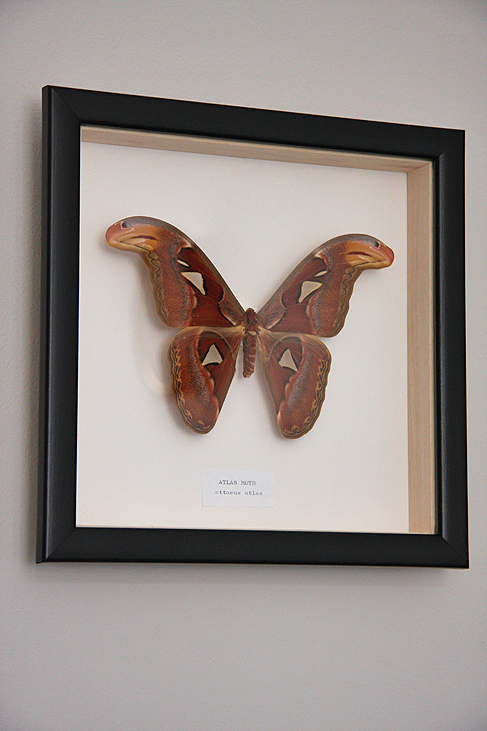 |
| Figure 51: Photo credit: Beth Rose (Permission pending) |
[7.3] Fagara Silk
(Fun fact #5: Silkworm or not?)
In North India, tropical China and some other parts of Asia, the Atlas moths are valued for their silk. Unlike their Silkworm moth relatives who make a cocoon out of one unbroken silk strand, the Atlas moth caterpillars construct their cocoon with broken strands of silk. The brown wool-like silk cocoons of the Atlas moths are collected for its durability to make what is termed the fagara Silk. The type of host food plant actually affects the colour of the silk, which ranges from various shades of brown and tan, while the resulting woven fabric will then turn out natural brown or beige [22]. The fagara silk can be weaved into an array of practical products such as purses, scarves, shoes and shirts. It is even claimed that in Taiwan, zippers are simply added to large enough vacated cocoons to be made into small purses without needing to deconstruct the cocoon [23]!
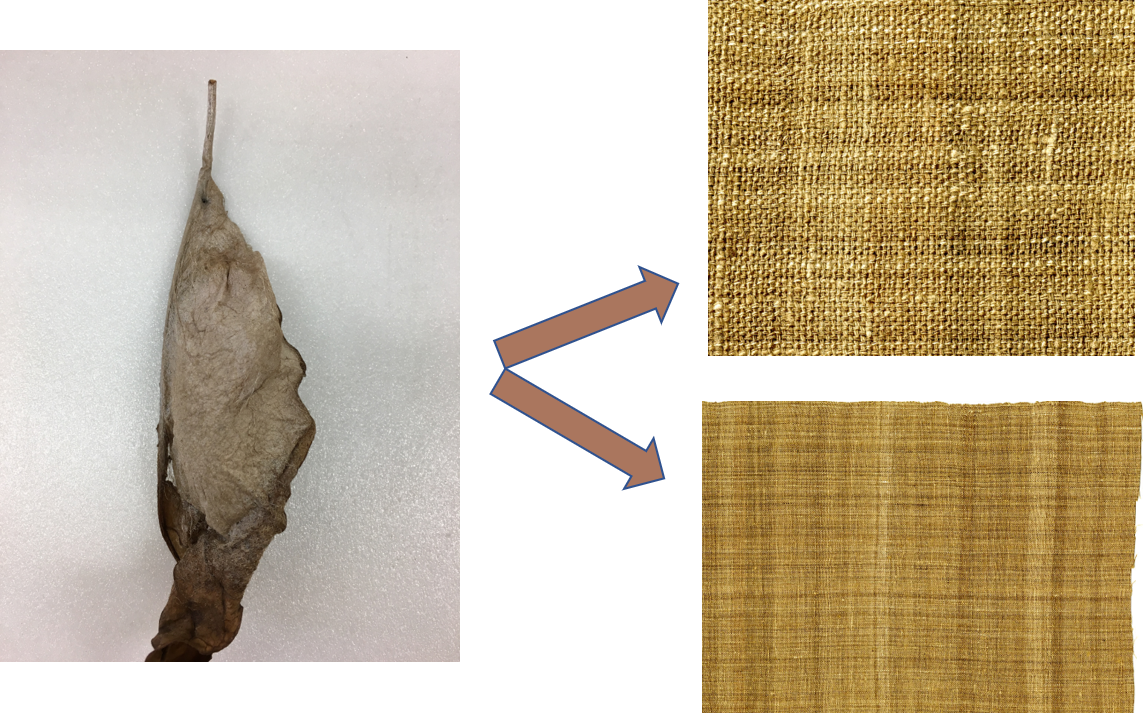 |
| Figure 52: Processing of fagara silk from the cocoon of Atlas moth into fabric! Image adapted from various sources [16], [17], [18] |
And there you have it, all 5 fun facts of the Atlas Moth! If you're still interested to find out more, do read the whole page instead!
[8.0] Taxonomy & Systematics
[8.1] Classification
- KINGDOM Animalia
- PHYLUM Arthropoda
- CLASS Insecta
- ORDER Lepidoptera
- FAMILY Saturniidae
- GENUS Attacus (Linnaeus, 1767)
- SPECIES Attacus atlas (Linnaeus, 1758)
[8.2] Original Species Description
| Figure 53: Original species description of Attacus atlas from Systema Naturae |
[8.3] Nomenclature
The Atlas Moth was first named Phalaena Bombyx Atlas by Linnaeus in 1758, but the species was subsequently moved to a different genus Attacus and is named Attacus atlas (Linnaeus, 1758).
[8.4] Synonymy
| Synonyms |
Author, Year |
Remarks |
| Phalaena Bombyx Atlas |
Linnaeus, 1758 |
Type locality: “Citro Asiae, Americae” herein fixed as Bogor, Djawa, Indonesia by present neotype designation |
| Phalaena Attacus Atlas |
Linnaeus, 1767; Martini, 1777; Cramer, 1780-1782 |
|
| Phalaena Atlas |
Fabricius, 1781; Gmelin, 1790; Donovan, 1798; Sepp, 1852-1855 |
|
| Phalaena Atlas vitrea |
Perry, 1811 |
|
| Bombyx Atlas |
Fabricius, 1775; Olivier, 1790; Laporte, 1830 |
|
| Bombyx Ethra |
Linnaeus & Olivier, 1790; Schüssler, 1933 |
|
| Saturnia Atlas |
Duncan, 1841; Fauvel, 1895 |
|
| Hyalophora Atlas |
Duncan, 1841 |
|
| Aglia atlas |
Pokorny, 1855; Schüssler, 1933 |
|
| Samia atlas |
Linnaeus & Kawada, 1932 |
|
| Attacus Atlante |
Linnaeus & Felder, 1861 |
|
| Attacus Atlantum |
Linnaeus, Felder & Felder, 1861 |
|
| Attacus (?) Vitrea |
Kirby, 1892 |
|
| Atlas attacus |
Moulton, 1920; Jones et al., 1982 |
[8.5] Type Information
No holotype was designated due to no type specimens being available to Linnaeus at the time of the original publication of Systema Naturae, where he first described Attacus atlas under the name Phalaena Bombyx Atlas based on 4 'syntype' figures with associated texts. These figures were exceedingly poor in quality and lacked or contain very vague information of the geographical origins of the specimens which served as the models for the illustrations in the 'syntype' figures. As such, due to the probable loss of the syntypes, each of these figures makes a poor foundation on which to base the name of this species [6].
Eventually, R. S. Peigler designated a specimen which is known to have correctly labelled with full data as a neotype for Attacus atlas. The labels on the neotype read: "Indonesia: Java, Bogor 250m, ex-cocoon II 1974, Liem Hwie Tijang; Genitalic prep. #42, R.S. Peigler; Neotype, Attacus atlas (Linnaeus), desig. Peigler," The neotype was deposited in the American Museum of Natural History (AMNH) [6].
| Figure 54: Neotype current in AMNH. Image adapted from A Revision of the Indo-Australian Genus Attacus by R.S. Peigler (1989). Obtained and accredited under fair use |
[8.6] Diagnosis
Attacus atlas is distinguished from other closely resembling species by the unique combination characters of a prominent patch of yellow or very orange yellow above and below the red dash and the pronounced white component of the antemedian and postmedian lines [6].
When placed with Attacus mcmulleni, the most resembling species to Attacus atlas, you can see the combination characters characteristic of Attacus atlas, in addition to its longer and thicker red dash [6].
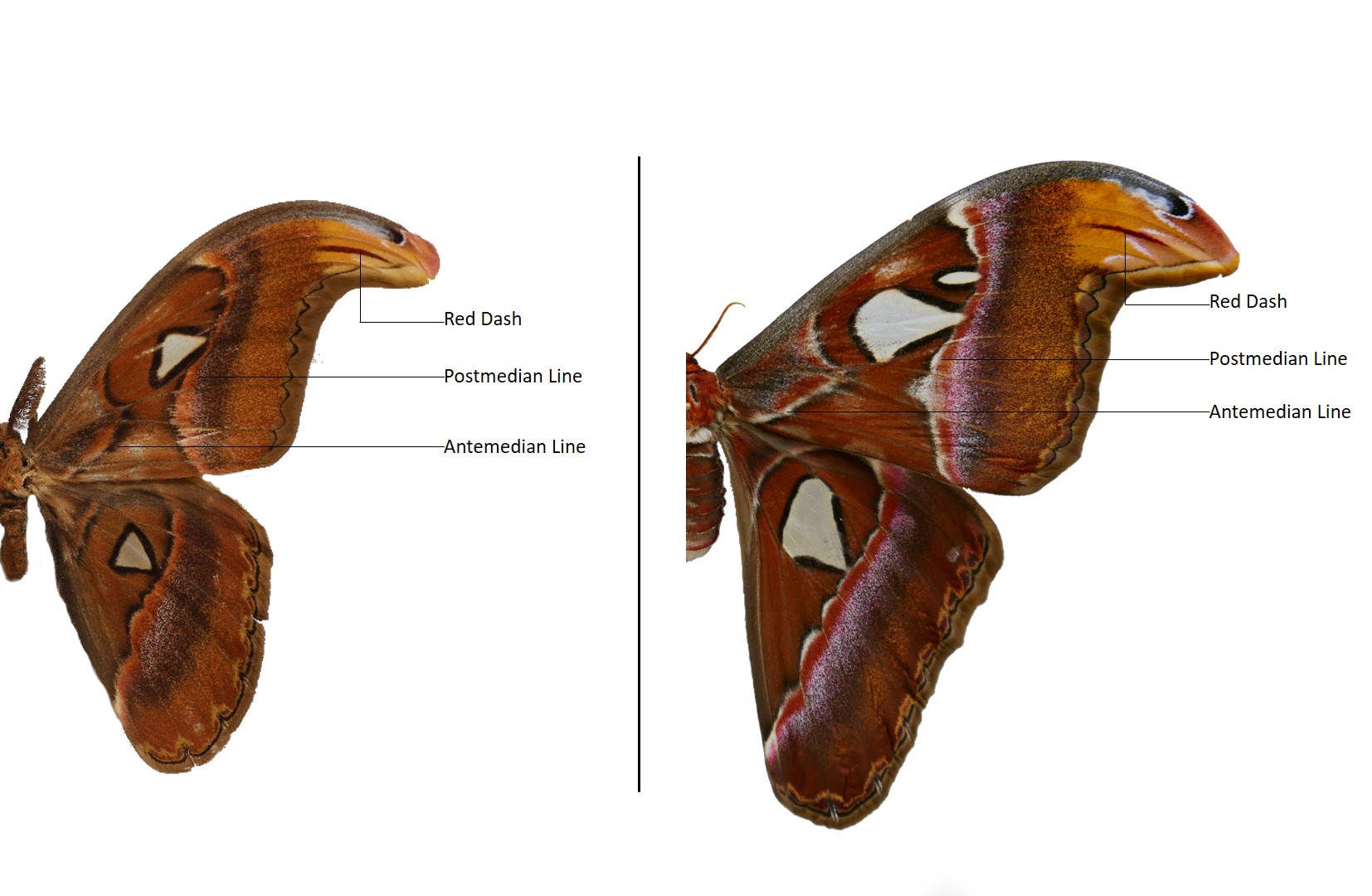 |
| Figure 55: Comparing Attacus mcmulleni (left) to Attacus atlas (right). Image adapted from various sources [19], [20] |
[9.0] Phylogeny
The taxonomic classification of the saturniid moths has always been a challenge. It is only recent molecular work on bombycoid relationships from Regier et al. (2008) that confirms the placement of Saturniidae into the superfamily Bombycoidea [26], which contains 3,400 species where adult moths range from being large to very large [24].
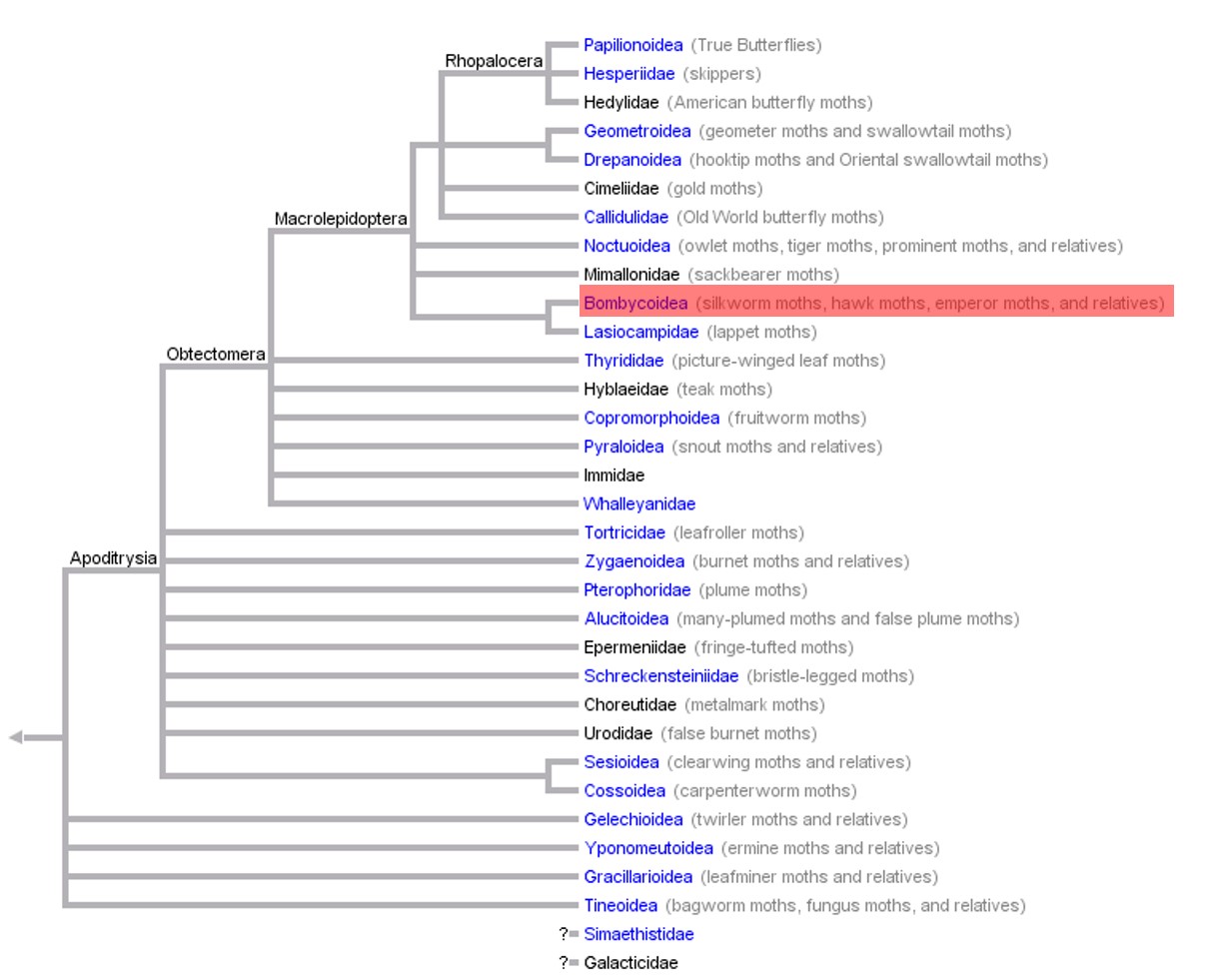 |
| Figure 56: Placement of Superfamily Bombycoidea on the tree of life. Photo credit: Tree of Life web project (licensed under the Creative Commons Attribution-NonCommercial License - Version 3.0) |
 |
| Figure 57: Placement of family, Saturniidae, on the tree of life. Photo credit: Tree of Life web project (licensed under the Creative Commons Attribution-NonCommercial License - Version 3.0) |
Attacus atlas then further belongs to the subfamily Saturniinae which is further divided into 5 tribes (Saturniini, Attacini, Bunaeini, Micragonini and Urotini) [25]. Attacus atlas belongs to the tribe Attacini, which contains roughly about 80 species and 9 genera distributed in both the Old World and New World [25]. Despite the presence of genetic relationship data within Saturniidae, phylogenetic relationships of these moth species are still pretty limited [26]. An earlier hypothesis of phylogenetic relationship of the genera belonging to the tribe Attacini was attempted by Peigler in 1989 who used a total of 21 morphological characters to form the basis for the analysis (shown in Figure 58) [25].
| Figure 58: Hypothesis of generic relationships of attacine moths based on morphological characters based on Peigler's work. Bootstrap values followed bydecay indices are displayed below internal branches. Tree by Friedlander et al. (1998). Obtained and accredited under fair use. |
In a later study by Friedlander et al. (1998), sequences from the nuclear genes for elongation factor-1a (EF-1a) and dopa decarboxylase (DDC) are tested for phylogenetic concordance with each other and with previous morphological evidence (from Peigler's work) within the giant silk moth tribe Attacini [25].
Analysis of all uniformly weighted nucleotides for DDC yields 8 most parsimonious (MP) trees whereby the strict consensus tree includes the monophyly of all multiply sampled genera which is supported by bootstrap analysis at 92% level or higher (Figure 59). Analysis of all uniformly weighted nucleotides for EF-1a yields 2 MP trees which strongly supports the same clades that are strongly supported by the DDC (more than 87% bootstrap values) for 7 out of 9 genera, with the placement of the other 2 to be not in strong conflict (Figure 60). Further, parsimony analysis of the combined nucleotide data results in increased branch support relative to DDC or EF-1a alone (Figure 61). For instance, 8 nodes in the combined analysis retain a 100% bootstrap values present in at least one of the genes separately; 2 nodes have higher support than either gene alone; 4 nodes have intermediate levels of support whereby 3 is higher in EF-1a and 1 is higher in DDC. Both genes are suitable for resolving relationships within Attacini as seen in the similarity in the topology of the separate gene trees. In addition, given that the two genes are concordant, the combined sequences thereby provide the best current estimate of the attacine phylogeny where most generic relationships appeared strongly resolved [25].
When compared with the recovered topologies for both the combined sequences and morphology data, 5 out of 8 generic-level attacine groupings are in agreement, with differences confined to basal divergences (Figure 62). As such, the conflicting differences in the groupings further highlighted the need to re-examine some of the morphological characters used in light of the molecular results. Taking into account additional morphological evidence, Friedlander et al. concluded that the relationships shown from the strict consensus MP tree of EF-1a is the most favoured (Figure 60) [25].
| Figure 59: Phylogenetic relationships based on analysis of uniformly weighted DDC sequences. (A) One of eight MP trees resulting from analysis of total nucleotides. Above each branch is listed the minimum number of possible character state changes, followed by thecorresponding maximum number. Below each internal branch is listed the bootstrap value followed by the decay index. (B) Strict consensus ofeight MP trees based on analysis of total nucleotides. Tree by Friedlander et al. (1998). Obtained and accredited under fair use. |
| Figure 60: Phylogenetic relationships based on analysis of uniformly weighted EF-1a nucleotide sequences. Strict consensus of two MP trees. Branches labelled as in Figure 59. Tree by Friedlander et al. (1998). Obtained and accredited under fair use. |
| Figure 61: Phylogenetic relationships based on combined analysis of uniformly weighted EF-1a and DDC sequences. (A) Strict consensus oftwo MP trees based on analysis of nucleotide sequences. Branches labelled as in Figure 59. Tree by Friedlander et al. (1998). Obtained and accredited under fair use. |
| Figure 62: Hypotheses of generic relationships of attacine moths together with geographic areas inhabited. (A) Morphological work by Peigler (1989). (B) Study by Friedlander et al. (1998). (condensed from Figure 60). Bootstrap values followed by decay indices are displayed below internal branches. Tree by Friedlander et al. (1998). Obtained and accredited under fair use. |
The following phylogenetic tree was reconstructed with a total of 13 Bombycoidea mitogenomes which included 9 Saturniidae, 3 Bombycidae and 1 Sphingidae [26]. Outgroups, which comprises a dipteran, Drosophila melanogaster, and a lepidopteran, Thitarodes renzhiensis, were used to root the tree [26]. Phylogenetic analyses were run with Maximum Likelihood (ML) approach with 1000 bootstrap replicates using two datasets, amino acid sequences of 13 protein-coding genes (PCGs) and nucleotide sequences of 13 PCGs plus 2 rRNAs to infer phylogenetic trees [26].
.
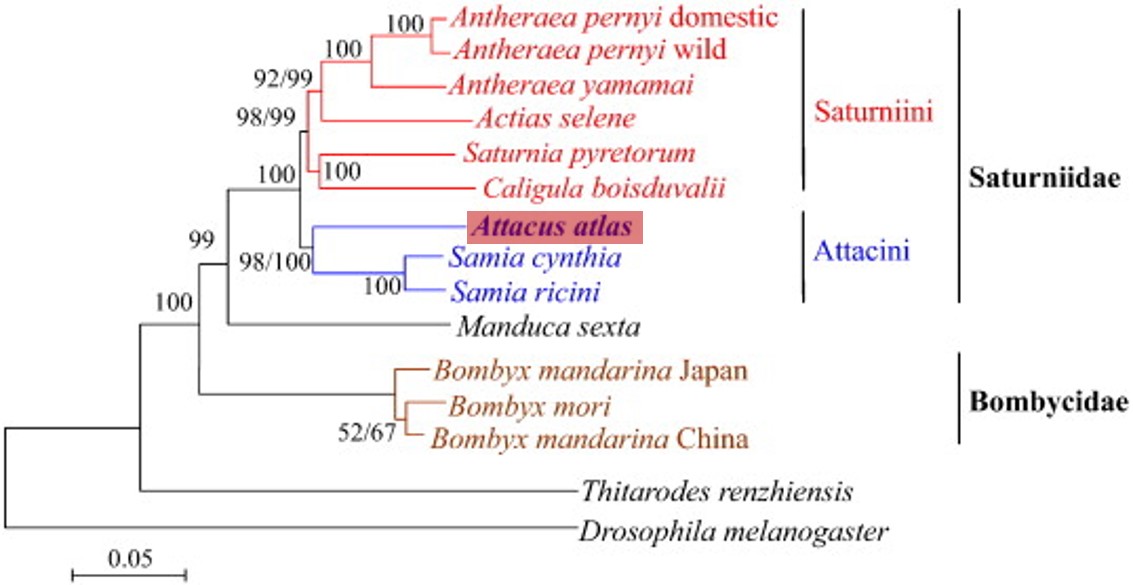 |
| Figure 63: Phylogeny of Bombycoidea species based on Maximum Likelihood analysis. The dipteran D. melanogaster, and lepidopteran T. renzhiensis were used as outgroups. Numbers at each node specify bootstrap percentages of 1000 replicates inferred from amino acid dataset and nucleotide dataset, respectively. The scale bar indicates the number of substitution per site. Tree by Chen et al. (2014). Obtained and accredited under fair use. |
Results from these phylogenetic analyses see that the optimal cladograms inferred by the two datasets are identical, whereby both highlighted that there are two distinct clades present, the Saturniidae and Bombycidae, which is consistent with morphological analysis and previous literature [26]. Strong bootstrap support (100%) by the ML analyses showed that Attacus atlas shares a close ancestry with the Samia species [26]. In addition, strong support (100% bootstrap value) from phylogenetic study supports the sister group relationship between the tribes Saturniini and Attacini, which is not only aligned with traditional morphological classification and more recent molecular works on the taxa but indicates a much higher support [26].
[10.0] Mitochondrial Genome
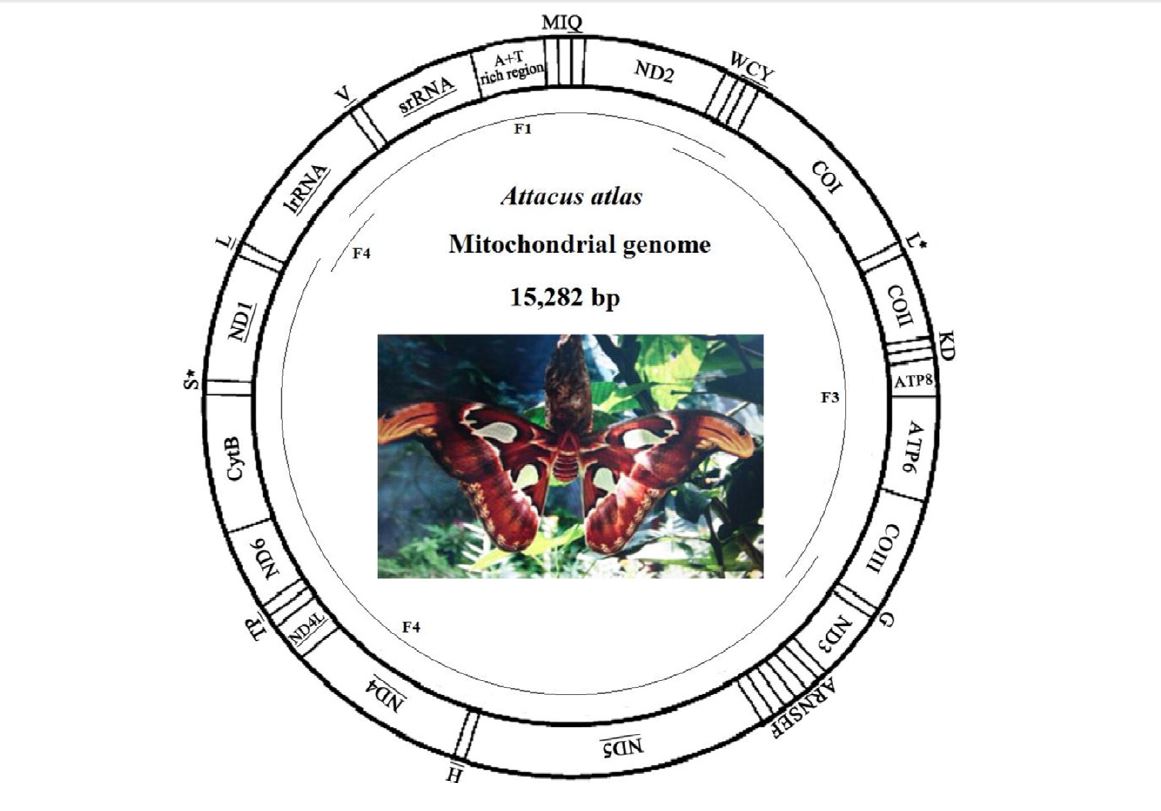 |
| Figure 64: Circular map of the mitogenome of Attacus atlas. tRNA genes are denoted as one-letter symbols. Gene names underlined indicate a counter-clockwise transcriptional direction, whereas those not underlined indicate a clockwise direction. Overlapping arcs (F1–F4) within the circle indicate the PCR amplified fragments. Diagram by Chen et al. (2014). Obtained and accredited under fair use. |
The complete mitogenome of the Atlas moth is a closed circular molecule of 15,282 base pairs in length. It consists of the typical set of 37 genes observed in metazoan mitogenomes, including 13 PCGs, 22 tRNA genes and 2 rRNAs.
[11.0] Image Sources
[1] Photo credit: Sebastian Ow
[2] Photo credit: Angela Chan (Permission obtained)
[3] Photo credit: Joe Coelho (Permission obtained)
[4] Photo credit: Guercino (from Wikimedia commons)
[5] Photo credit: Carlos Perez (Permission obtained)
[6] Photo credit: Marie-Lan Nguyen (from Wikimedia commons)
[7] Photo credit: aokcreation (Permission obtained)
[8] Photo credit: John Hoppner (from Wikimedia commons)
[9] Photo credit: Heinrich Fuger (from Wikimedia commons)
[10] Photo credit: Tom Schultz (Permission obtained)
[11] Photo credit: David Beadle (Permission obtained)
[12] Photo credit: Image obtained from Wikimedia commons
[13] Photo credit: Anaxibia (licensed under the Creative Commons Attribution-Share Alike 4.0 International license)
[14] Photo credit: David Cappaert (Permission pending)
[15] Photo credit: Quartl (licensed under Creative Commons CC BY- SA 3.0 license)
[16] Photo credit: Sebastian Ow
[17] Photo credit: Mississippi Entomological Museum (Permission pending)
[18] Photo credit: Mississippi Entomological Museum (Permission pending)
[19] Photo credit: Natural History Museum (licensed under Creative Commons CCZero)
[20] Photo credit: Foo Maosheng (Permission obtained)
[12.0] References
[1] Ng, P. K., Corlett, R., & Tan, H. T., 2011. Singapore Biodiversity: An Encyclopedia of the Natural Environment and Sustainable Development. Editions Didier Millet.
[2] Kritsky, G., & Cherry, R., 2000. Insect mythology. iUniverse.
[3] Hamilton, E.,1942. Mythology. Little, Brown and Company.
[4] Macrone, M., 1992. By Jove! Brush up your mythology. Cader, New York
[5] Yiu, V., 2006. Insecta Hongkongica. Hong Kong Discovery. Kowloon, Hong Kong. 655pp.
[6] Peigler, R. S., 1989. A revision of the Indo-Australian genus Attacus. Lepidoptera Research Foundation.
[7] Nath, C., Bordoloi, P. K., Chutia, B. C, Gogoi, L. & Goswami, B., 2016. A new record of six larval instars in Attacus atlas L. (Saturniidae) from North Eastern India. Journal of Entomology and Zoology Studies. 4(3): 399-401.
[8] Bhawane, G. P., Mamlayya, A. B., Koli, Y. J., PHONDE, Y., ALAND, S., & GAIKWAD, S., 2011. Life History of Attacus atlas Linn. (Saturniidae: Lepidoptera) on Sapium Insegne Benth. From Western Ghats, Maharashitra. Life,6(3), 497-500.
[9] "Atlas moth" by Tan, R., 2008, Wild Factsheets, WildSingapore, URL: http://www.wildsingapore.com/wildfacts/insecta/atlas.htm
[10] Foo, M., 2017. An atlas moth infestation at Yishun. Singapore Biodiversity Records 2017: 80-81, URL: https://lkcnhm.nus.edu.sg/app/uploads/2017/09/sbr2017-080-081.pdf
[11] "The Atas Moth Chronicles Episode 1: The Arrival of the Moths" by Wee, Y. C., 2012, Hosted on Butterflies of Singapore: http://butterflycircle.blogspot.sg/2012/08/the-atlas-moth-chronicles-episode-1.html
[12] Kons, H., 1998. Chapter 32: Largest Lepidopteran Wing Span.University of Florida, Department of Entomology & Nematology. URL: http://entnemdept.ifas.ufl.edu/walker/ufbir/chapters/chapter_32.shtml
[13] Carwardine, M., 2008. Animal Records. Sterling Publishing Company, Inc..
[14] Flindt, R., 2006. Amazing numbers in biology. Springer Science & Business Media.
[15] Chakravarthy, A. K., & Sridhara, S., 2016. Arthropod Diversity and Conservation in the Tropics and Sub-tropics. Springer.
[16] "The Atlas Moth - The Remarkable Yet Unknown Species of India." by JungleSutra, 2016. Hosted on JungleSutra- Wildlife Journeys by Creative Travel: https://junglesutra.wordpress.com/2016/08/01/the-atlas-moth-the-remarkable-yet-unknown-species-of-india/
[17] "Attacus atlas Linnaeus, 1758". n.d. Hosted on The Digital Nature Archive of Singapore: https://lkcnhm.nus.edu.sg/dna/organisms/details/462
[18] "atlas moth (Attacus atlas)", n.d.Hosted on Plantwise Knowledge Bank, URL: http://www.plantwise.org/KnowledgeBank/Datasheet.aspx?dsid=7853
[19] Hill, D. S., 2008. Pests of crops in warmer climates and their control. Springer Science & Business Media.
[20] Deml, R., & Dettner, K.,1994. Attacus atlas caterpillars (Lep., Saturniidae) spray an irritant secretion from defensive glands. Journal of chemical ecology, 20(8), 2127-2138.
[21] "Mothra". Hosted on Wikizilla, the Godzilla, Kong, Gamera and Kaiju Wiki, URL: https://wikizilla.org/wiki/Mothra
[22] "Attacus atlas (L) Fagara Silk" , n.d. by Jennifer Seltzer. Hosted on Mississippi Entomological Museum, URL:
http://mississippientomologicalmuseum.org.msstate.edu/AnthroEnt/Textiles/Species/Attacus_Atlas_.html#.Wgw9imiCw2x
[23] Jugale, S. B., 2010. Major Insect Pests of Xylocarpus granatum koen., A Critically Endangered Mangrove Species of Maharashtra.
[24] "Lepidopteran Evolution And Paleontology" by Joseph Culin. Hosted on Encyclopaedia Britannica, URL: https://www.britannica.com/animal/lepidopteran/Evolution-and-paleontology#ref894424
[25] Friedlander, T. P., Horst, K. R., Regier, J. C., Mitter, C., Peigler, R. S., & Fang, Q. Q., 1998. Two nuclear genes yield concordant relationships within Attacini (Lepidoptera: Saturniidae). Molecular phylogenetics and evolution, 9(1), 131-140.
[26] Chen, M. M., Li, Y., Chen, M., Wang, H., Li, Q., Xia, R. X., Zeng, C. Y., Li, Y. P., Liu, Y. Q. & Qin, L., 2014. Complete mitochondrial genome of the atlas moth, Attacus atlas (Lepidoptera: Saturniidae) and the phylogenetic relationship of Saturniidae species. Gene, 545(1), 95-101.
[27] "Attacus atlas -- "Atlas Moth", n.d. Hosted on https://breedingbutterflies.com/attacus-atlas/
[28] Sukirno, S., Situmorang, J., Sumarmi, S., Soesilohadi, R. H., & Pratiwi, R., 2013. Evaluation of artificial diets for Attacus atlas (Lepidoptera: Saturniidae) in Yogyakarta special region, Indonesia. Journal of economic entomology, 106(6), 2364-2370.
